#like half of the entertainment industry was supporting her during her trial
Explore tagged Tumblr posts
Note
nabi has the whole world wrapped around her fingers with just her scene alone 💅💅
not sure what scene ure talking about, but it’s true. she has sooooo many people wrapped around her finger and it’s so cute!
#like half of the entertainment industry was supporting her during her trial#and then youve got all her besties (and theres a lot of them) so shes just a beloved person#💌 — moots#💌 — txt-yaomi#💌 — answered
6 notes
·
View notes
Text
So 2020 sucked... but the films didn’t! The top twenty films of 2020 (in my humble opinion).

AT LAST. This godforsaken year is over and as we venture into a new year, let's hope and pray that the art’s industry finds a way to build themselves back up again, in a way that is safe and necessary for them to bring us the entertainment we so crave. It has been a crazy and unprecedented year for the film industry, a year that it has never seen with losses of an estimated $5 Billion at the end of March. Some of the most anticipated blockbusters of all time had to be put on hold and postponed for hopefully next year with No Time to Die, A Quiet Place II, Wonder Woman 1984, Dune and Black Widow being a slim few that never got onto a silver screen this year. However, there is no reason to fret or relinquish the loss film has had this year, as hopefully next year once we’ve had a better understanding of this virus, these films along with many others will have their audience. Amongst the postponed releases, many films have been resilient to the virus and still managed to gain a spot in the cinema despite the circumstances.

Christopher Nolan’s Tenet was the only multi-million dollar film to be released this year and even though the risk of release could have meant nothing for the film, it still managed to rake in a staggering $361 million, an expected profit for a film of its size. However, despite the film's success, Nolan made it clear that this shouldn’t be taken lightly and that the safety of film consumers comes before the profits themselves.

Even though we will have to be more cautious in the cinema, films will return, once we have regulated safety measures in cinemas and film festivals to ensure that customers can feel comfortable. For now, HBO has planned to put many releases from Warner Bros. straight onto its streaming platform as well as in the cinema next year, in an attempt to prevent the spread of COVID whilst still being able show the films we’ve been craving. There’s no telling what next year will bring, what the Oscars will look like or if filming for the next Batman film will ever end, however it's clear to see that the film industry has shown resilience amongst this pandemic and will continue to do so in years to come, no matter the challenges.
Here are twenty of the films that made it to the cinema (or streaming platforms) this year, that proved the durability of the film industry during this time.
20. Tenet directed by Christopher Nolan

We can all agree that Chrisopher Nolan’s Tenet should be handed the award of Most Confusing Yet Entertaining Film of the Year, or ever made in fact. The sci-fi epic adventure that sees its lead (named “the protagonist) travel back in time and then forward in time and then back in time again (?)... yup, I didn’t get it either, but I’m not the only one seeing as Robert Pattinson who played alongside John David Washingston hadn’t a clue what was going on either. And he was in the film. However, despite the film's confusion, it doesn’t make it a bad or “lazy” film, for every aspect of this film from lighting, sound design, casting, direction, stunts WAS ON POINT and those elements are truly what sets this film apart. The story may have been perplexing but at least there was one.
19. Nomadland directed by Chloé Zhao

It is such a shame that Nomadland may not get the audience it deserves due to the COVID-19 pandemic as it is a truly moving and rich film. The Nomads are a group of real Americans who’ve hit the road in various mobile homes after the Great Recession in 2008 caused millions to be homeless and redundant. Frances McDormand plays Fern, one of these Nomads and child of the road whilst the film follows her simple, yet melancholy journey across Western America. Chloé Zhao has been tipped several times for an Oscar with Nomadland after winning the Golden Lion at this year’s Venice Film Festival. Let’s hope that if this goes onto the Academy Awards, Nomadland will find the audience it so craves.
18. Uncut Gems directed by the Safdie Brothers

YES, Uncut Gems came out THIS YEAR, which is an insane thought seeing as I saw the film in a packed cinema before it was released onto Netflix. The Safdie Brothers, Josh and Benny brought us Uncut Gems this year, a declining tale of a man’s test with fate and the many many second chances he gets at life, only to f*** all of them up. Adam Sandler plays Howard Ratner, a pawn shop owner and frequent gambler. This is Sandler’s best ever role and the multifaceted, gritty work of the Safdie Brothers (Heaven Knows What, Good Time) really brought something brilliant out of him.
17. The Half of it directed by Alice Wu
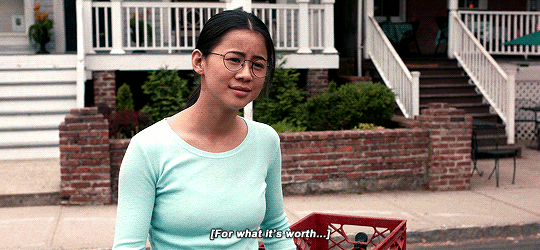
The Half of It wins the Most Surprising Film of the Year. A highly credible film directed by Alice Wu, The Half of It is EVERYTHING we want and need in this world. In fact, it’s everything we kind of already have in this world, but hardly see on screen. Non white leads, queer non stereotyped relationships, unpredictable endings; The Half of It was an all rounder for me. Some may roll their eyes at the amount of diverse elements to the film and see it as a way of gaining brownie points, but why does that have to be a thing? Why can’t having active and authentic representation across all films just be normal rather than political? If anything, it should be encouraged. The story was brilliant (and made me cry) as it had so many layers to it as well as the characters.
16. 7500 directed by Patrick Vollrath

Definitely the wildcard of this list, 7500 is an Amazon Studios film starring Joseph Gordon Levitt. I’ll admit, my hopes weren’t high, but after taking the time to watch this film I was truly blown away. And who KNEW Joseph Gordon Levitt could be so deep and in tune with his emotions on screen. He plays a pilot whose plane gets hijacked mid flight. There. Enough said. I could hardly BREATHE throughout this film in apprehension of what was going to happen next.
15. Kajilionaire directed by Miranda July
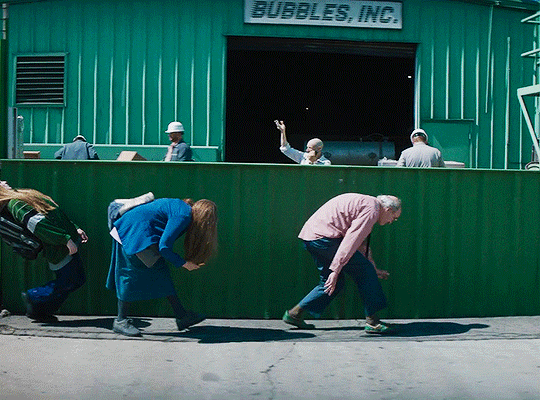
2020 thus far has been the best year for female filmmakers. From Céline Sciamma’s Portrait of a Lady on Fire, Josephine Decker’s Shirley, Rose Glass’ Saint Maud and Miranda July’s Kajilionaire, a clear cut foundation has been carved effortlessly for female filmmakers this year. Miranda July’s Kajilionaire especially rocked my senses a little as I saw so much unfamiliarity yet beauty within this film. A simple storyline that follows Old Dolio (Evan Rachael Wood), a young woman trying to feel more connected with her parents. A certainly bittersweet tale that has this rose tinted like vibe to it that attaches itself to the visuals and music of the film, that make everything feel light and playful. This contrasts well with the story itself as being sad and melancholy, further proving the fact this film is more than face value. Face value films have never gotten us anywhere and its films that go beyond entertainment that truly last in the industry.
14. Bombshell directed by Jay Roach

Bombshell is a PERFECT title for this film; a film that left me angry, sad and questioning the immorality that is still prevalent in the mostly male dominant society we live in. Charlize Theron, Margot Robbie and Nicole Kidman (best trio ever) star as three news anchors on Fox news whose lives are brutally torn apart when the Head of Fox News, Roger Ailes is accused of sexual harassment on many different occasions by female members of the workplace. Despite the silence being now broken, these three women still face a whole load of other problems that come in speaking up against a powerful, white and rich male. Threats of permanent job losses, victim blaming and a weak image are the consequence of speaking up about sexual assault as a member of Fox news. The brand itself has an incredibly misogynistic view of women and continues to have an idealised image of how women should be on the news with those working at Fox actually admitting it brings in viewers. Women with tons of makeup and dresses shorter than is comfortable is Fox news and Bombshell went above and beyond exposing this scandal that truly shook American broadcasting forever.
13. Borat Subsequent Movie Film directed by Jason Woliner

Borat Subsequent Movie Film wins the award for Most Jaw Dropping Film of the Year, as its protagonist and creator Sacha Baron Cohen, went above and beyond to show us the true dark depths of America. Ballsy, outrageous, jaw dropping, scandalous; every bold word can be used to describe this film and the lengths it went to get right to the heart of American society. The ugly heart. By now you should be aware that the ex president’s attorney was shoved right into the firing line after he was taken into a hotel bedroom by a reporter who happened to be an actor. Rudi Gulliani was left red faced after Borat bursts into the hotel room proclaiming the young reporter is his daughter, with Gulliani still unaware the entire outrageous event had been caught on camera. And not just any camera. A MOVIE camera. A true triumph in free speech and comedy, Borat Subsequent Movie Film will live on forever as the most outlandish film there is.
12. Miss Juneteenth directed by Channing Godfrey-Peoples

A real eye opener into current American society using a touching story between mother and daughter as a backdrop. Turquoise is a single mother struggling to get by and support her daughter Kai through the Miss Juneteenth pageant, held annually in Fort Worth, Texas. A real competition, the Miss Juneteenth pageant promises one lucky young woman of colour a full scholarship to a black historical college of their choosing. Turquoise desperately wants this for her daughter as it’ll give her the opportunities in life she never had. A truly moving and authentic film, this scored 100% on Rotten Tomatoes which is a highly impressive and deserving score.
11. The Trial of the Chicago Seven directed by Aaron Sorkin
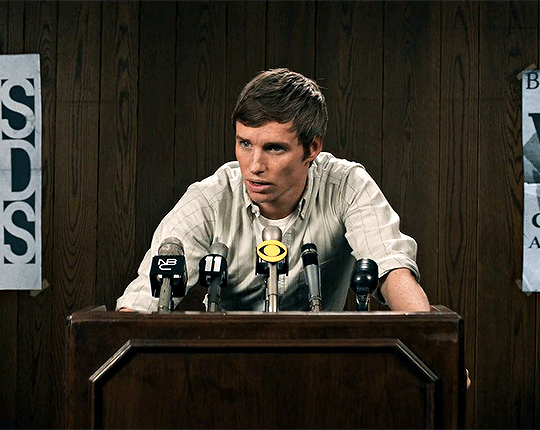
Aaron Sorkin’s lyricism in words was again brought to us on screen this year with his depiction of the Chicago 7 (eight if you count Bobby Seale); seven men who were accused and put on trial for eliciting the Chicago riots of 1968. When in actuality, the police themselves had more to do with riling up the protestors than anyone else, even pushing a crowd of protestors through the front window of a restaurant to make it seem like they had vandalised the property. If anyone was going to make such a film, Sorkin would be the one to do it as with any event or idea he covers, Sorkin’s words as a writer MAKE YOU CARE. Even when you had no recollection or understanding of something, the way Sorkin depicts these events on screen has you absorbed into the story till the last second. An incredible and powerful story and a film that I could constantly go back to in order to learn about the injustices of American politics.
10. The Devil All the Time directed by Antonio Campos
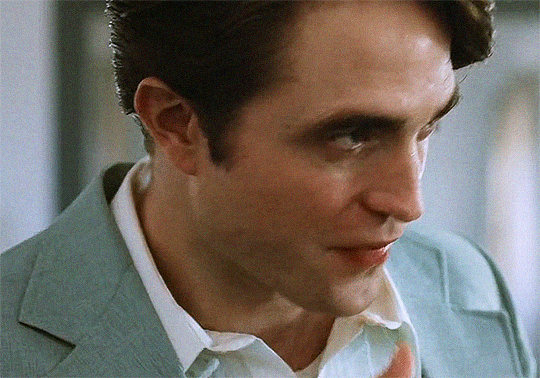
I feel like The Devil All the Time still hasn’t got the recognition it deserves. There is something incredibly powerful and priceless about having a group of exceptionally talented people come together to create something for screen. This film wins Best Casting of the Year (if you don’t count Dune) as the likes of Tom Holland, Robert Pattinson, Eliza Scanlen, Sebastian Stan, Bill Skarsgård, Mia Wasikowska, Harry Melling, Riley Keogh, Jason Clarke and Haley Bennett graced our screens in this dark and ominous tale. Any story that is set in a small town and is about stories interweaving is bound to be interesting and thought provoking in it’s telling, with this adaptation being no different. The star of the show was Robert Pattinson’s thick Tennessee accent along with his clean yet filthy character interpretation of a perverted priest. Not one line in this film was thrown away and every single moment held a weighty tension, further confirming to us each character’s downfall by the end. An amazing adaptation and something you will reeeeeally enjoy.
9. Soul directed by Pete Docter

What was supposed to be Pixar’s second release of the year, Soul is Pixar’s most highly executed film to date. The amount of detail and care the animators and creators of Soul had taken to this picture is INSANE; insanely beautiful. With the black community going through so much this year, having something like Soul be put out to audiences shows support of this ever changing and growing movement. Even though having black representation on screen isn’t on the top of everyone’s priority list, it’s still important that the effort is there in order to really show what the world is like on screen and to cater to more audiences. Soul itself had everything; diverse, three dimensional characters, a clear and heart warming story and comedic, uplifting points that only strengthened the important message of this movie; life itself.
8. The Lighthouse directed by Robert Eggers
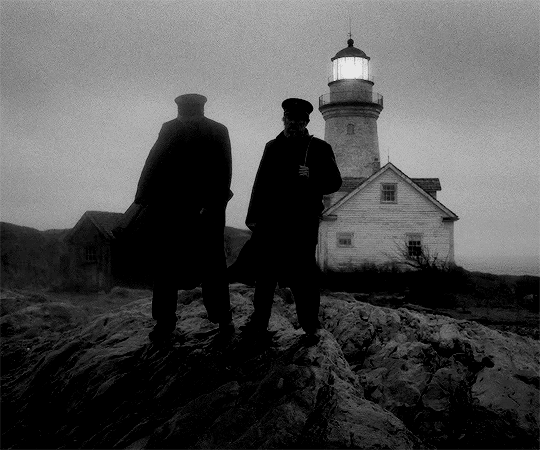
Again, another film that came out right at the beginning of the year, Robert Egger’s The Lighthouse was a whole new world that we had never seen before. Shot on a Panavision Millennium XL2 using a lense from the 1930s and black and white film, The Lighthouse was a decrepit, eerie and brilliant movie to watch throughout. It just makes me satisfied as a viewer when a director not only creates a film, but creates one that is so beyond anything we’ve ever seen and could likely have been made in an entirely different era altogether. Robert Pattinson KILLED IT in his role as a surly drunken sailor alongside Willem Dafoe, whose Irish accent was enviable. Overall a highly executed film that exudes brilliance and a creative mind.
7. The Hater directed by Jan Komasa
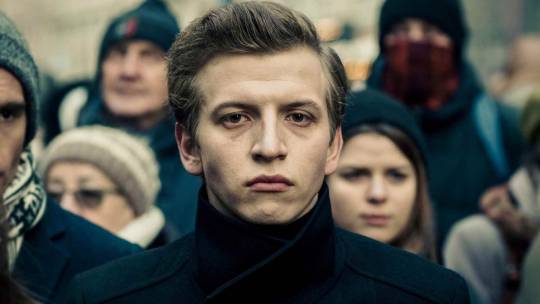
I would say The Hater is the second wildcard on this list. It’s a Polish drama that hasn’t had a lot of rep in the media, however, this doesn’t detract from the film’s execution and drama. A real downfall story that sees a jealous ridden man go from a media intern into illicting terrorism. Like, HELLO how does one go to such an extreme? The only way to find out would be watching the film...The film really spoke to the dangers of social media and the ease of getting someone to insight violence onto someone else, all through a computer. My mouth was hanging on the floor during several moments of this film and I can 100% guarantee the Netflix film will have the same affect on you.
6. La Belle Époque directed by Nicolas Bedos

La Belle Époque (or “The Good Times”) wins the award for Most Heart Warming Film of the Year. A surprisingly unique concept that follows a man trying to relive the best moments of his past after his wife wishes to divorce him. A company that specialises in creating your past memories offers him the opportunity to go back to the time when he and his wife first met, using actors, set design and music to recreate the moment. The French film emits a strong sense of nostalgia throughout with brilliant music and set design. It’s just one of those films that heavily expresses the idea of “what if” within a film whilst answering it boldly through its unique story.
5. Ema directed by Pablo Larraín
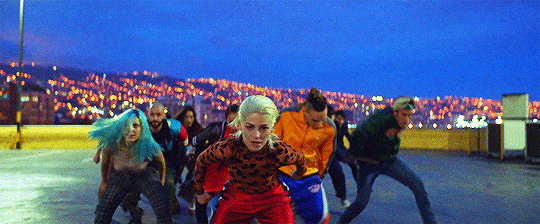
Ema took me a few days to fully absorb and appreciate as an experimental film, rather than one with a clear cut narrative. It's a film that expresses an idea, a feeling as opposed to a story which is completely okay and doable in this day and age. Ema is a liberating, freeing and psychedelic world of a film, with the message of the film being wrapped up in Ema’s attitude as a woman and the way she sets fires to things wherever she goes. Literally, as the opening sequence is of her setting alight a basketball hoop. There is some strong, vivid imagery within this and the MUSIC...definitely the best sound track I’ve heard this year. Ema’s in my top five for its uniqueness, rawness and the weird sense of liberation it gave me after watching it.
4. Saint Maud directed by Rose Glass
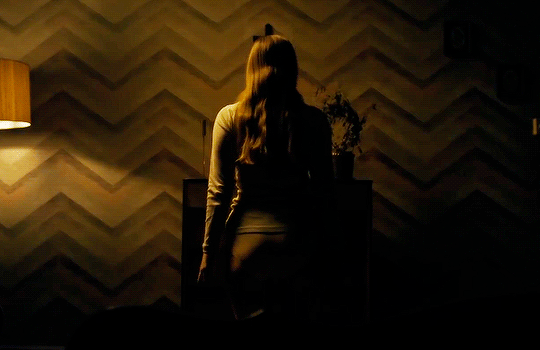
Probably the biggest breakthrough film of the year and despite the pandemic, Saint Maud certainly got the rep it deserved. An entirely new perspective of horror was brought to use in troves in the form of this Irish film created by first time director Rose Glass. I cannot express how brilliant and revolutionary Saint Maud was for its simplicity, story and filmmaking techniques. An ambitious and all round brilliant film that sits prettily in my top five films of the year.
3. Portrait of a Lady on Fire directed by Céline Sciamma
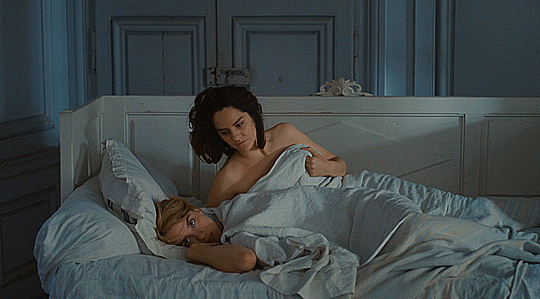
Portrait of a Lady on Fire wins the award for Best Foreign Language Film and it still hurts to think it never even made it to the Academy Awards this year. One of the most moving and earthy films that I’ve seen this year, Portrait of a Lady on Fire is a slow, sensual and ambiguous picture that shows a love story between two women through the form of art. I became quite obsessed with the music of Antonio Vivaldi after seeing this as the time period and music intertwined really well in this film. Exceptionally made and incredibly raw, Portrait of a Lady on Fire went straight for the heart in this film by also putting the grievances of love at the forefront of this film.
2. Parasite directed by Bong Joon Ho
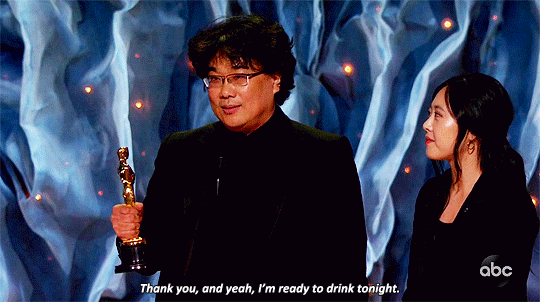
You are probably extremely bored and tired of hearing of the success of Parasite as a breakthrough picture, however there are an abundance of reasons for it! Winner of Six Academy Awards including Best Picture, Parasite really pulled the rug beneath the Academy Awards feet and certainly proved that no matter your race, it's the story that sells and that will bank you an Academy Award. A wonderfully crafted story, one that could have been found in theatre or even opera and those sort of structured narratives are what really grab people’s attention.
1. Another Round (Druk) directed by Thomas Vinterberg
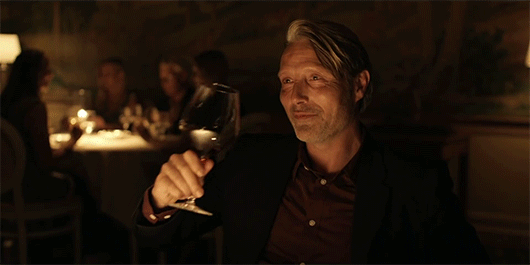
And finally, my favourite, Most Enjoyable Film of the Year had to be without a doubt, Thomas Vinterburg’s Druk, which I had the pleasure of seeing at the BFI London Film Festival this year. The theatre-like structure of a narrative has been implemented seamlessly into this film and even if structure means nothing to you, you can feel when a film has been crafted differently to bring about a dynamic and earthy narrative. I’ve previously watched two films of Vinterberg’s; Festen and The Hunt and even though those two films hold a high rating, Druk is definitely Vinterberg’s best film yet. Extremely entertaining whilst also carrying a rather dark side to it, Vinterberg sells you the best and worst of two worlds whilst exposing the effects of alcohol consumption.

And that’s it! 2020 in films! If you agreed or disagreed with anything on this list or think something else should’ve made the list that came out this year, be sure to leave me a comment on this post or via instagram on @ratingtheframe. It’s crazy to think that this obsession of mine turns two years old next year and there are still so many amazing pictures to be seen! And as always, you will find each and every one of them right here on @ratingtheframe.tumblr.
Bring on 2021!
#tenet#robert pattinson#john david washington#christopher nolan#nomadland#chloezhao#frances mcdormand#uncutgems#thesafdiebrothers#adamsandler#netflixfilm#thehalfofit#7500#joseph gordon levitt#amazonstudios#kajilionaire#mirandajuly#bombshell#charlizetheron#nicolekidman#margot robbie#borat subsequent moviefilm#sacha baron cohen#miss juneteenth#the trial of the chicago 7#aaron sorkin#netflixfilms#the devil all the time#tom holland#bill skargård
49 notes
·
View notes
Text
SHE IS RARE.

Selena Marie Gomez also know as Selena Gomez was born on July 22, 1992 (28 years old) in Grand Prairie, Texas. Her father is Ricardo Joel Gomez and Her mother is Amanda Dawn "Mandy" Cornett, a texas-born former stage actress. Selena was named after Tejano singer Selena Quintanilla, who died in 1995. Her father was originally from Mexico while her mother, has some Italian ancestry. Her parents divorced when she was five years old, and she remained with her mother. Selena has two younger half-sisters: Gracie Elliot Teefey, through Amanda and her second husband Brian. And Victoria "Tori" Gomez, through Ricardo and his second wife Sara. She received her high-school diploma through homeschooling in May 2010. Her mother gave birth to Selena when she was sixteen years old. She captured an interest in pursuing a career in the entertainment industry because she always see her mother preparing for stage productions. Selena began auditioning for numerous roles. She meets Demi Lovato during her audition for Barney & Friends in 2002, Selena portrayed the character of Gianna. It was her first acting experience. She appeared in thirteen episodes in 2002 and 2004 of Barney & Friends.

She had a cameo part in the film Spy Kids 3-D: Game Over (2003). She made-for-television film Walker, Texas Ranger: Trial by Fire (2005). She also made a guest appearance in the episode of the Disney series The Suite Life of Zack & Cody (2006). She has starred in the films Another Cinderella Story (2008), Princess Protection Program (2009), Wizards of Waverly Place: The Movie (2009), Ramona and Beezus (2010), Monte Carlo (2011), Spring Breakers (2012), Getaway (2013), The Fundamentals of Caring (2016), The Dead Don't Die (2019), and A Rainy Day in New York (2019). She also voiceover the character of Mavis in the Hotel Transylvania film franchise (2012–present). And she is also the executive producer the Netflix television series 13 Reasons Why (2017–2020), and Living Undocumented (2019).

Selena released three albums with her former band, Selena Gomez & the Scene: Kiss & Tell (2009), A Year Without Rain (2010), and When the Sun Goes Down (2011), all of which peaked within the top ten on the US Billboard 200 and attained gold certifications. Selena has also released three albums as a solo artist: Stars Dance (2013), Revival (2015), and Rare (2020), all of which debuted atop the Billboard 200. Selena has earned eight top-ten singles on the Billboard Hot 100. In 2017, Billboard reported that Selena has sold over 7 million albums and 22 million singles worldwide. She received various of appreciation and was honored as the Billboard Woman of the Year in 2017. She has a large number of followers on social media, and was one of the most-followed individual on Instagram. Selena has been described as a pop artist. She possesses a mezzo-soprano vocal range, her songs are influenced by dance-pop and EDM.

Selena released three albums with her former band, Selena Gomez & the Scene: Kiss & Tell (2009), A Year Without Rain (2010), and When the Sun Goes Down (2011), all of which peaked within the top ten on the US Billboard 200 and attained gold certifications. Selena has also released three albums as a solo artist: Stars Dance (2013), Revival (2015), and Rare (2020), all of which debuted atop the Billboard 200. Selena has earned eight top-ten singles on the Billboard Hot 100. In 2017, Billboard reported that Selena has sold over 7 million albums and 22 million singles worldwide. She received various of appreciation and was honored as the Billboard Woman of the Year in 2017. She has a large number of followers on social media, and was one of the most-followed individual on Instagram.

Selena released her own clothing line, Dream Out Loud by Selena Gomez, through retailer Kmart in 2010-2014. In 2012, she released a self-titled fragrance, Selena Gomez by Selena Gomez and in 2013, she released her second fragrance, Vivamore by Selena Gomez. She also created her own nail polish color collection for Nicole by OPI. From 2013-2015, Selena was a spokesperson and partner for Neo by Adidas. In 2015, she signed $3 million endorsement deal with Pantene. In 2016, She appeared in a fashion campaign for luxury brand Louis Vuitton. She also appeared in advertisement for Coca-Cola's "Share a Coke" campaign. In 2017, She confirmed that she was partnering with Coach, Inc. She has a limited-edition collection of handbags called the "Selena Grace" that she designed in collaboration with luxury brand Coach, Inc. She also partnered with the athletic brand, Puma, as brand ambassador appearing in campaigns. Her collection in collaboration with Puma called SG x PUMA, Strong Girl collection was launched on December 12, 2018. In September 2020, Selena launched her own makeup line, "Rare Beauty".

Selena was raised as a Catholic. In 2014, She said that she listened to "Oceans (Where Feet May Fail)" by Hillsong United before performing at the 2014 American Music Awards. In 2016, she appeared at Hillsong Young & Free concert in Los Angeles, leading worship by singing her song titled "Nobody" where the lyrics are referred to God. She also covered Hillsong Worship's song "Transfiguration" during her Revival Tour. As of 2020, she attends a different gatherings in California, the Hillsong Church, and she has stated that she does not consider herself religious but more concerned with her faith and relationship to God.

In 2008, Selena dated Nick Jonas. In December 2010, Selena began dating Justin Bieber. After separating in November 2012, they reconciled a few weeks later before breaking up again in January 2013. They later reconciled for a few months in each of 2013, 2014, and 2015. In 2017, it was reported that the couple were back again together. But, they broke up again in March 2018. In 2015, After recording "I Want You to Know" with DJ Zedd, Selena began a romantic relationship with him; they broke up later that year. In January 2017, Selena reportedly started dating The Weeknd.

Selena was diagnosed with lupus in 2012-2014. On September 2017, she announced that she had received a kidney transplant from actress and best friend Francia Raisa. During the transplant, She broke an artery. They build a new artery using a vein from her leg. Selena has been diagnosed with both anxiety and depression. On April 3, 2020, Selena revealed that she had been diagnosed with bipolar disorder.

Selena has shown her support for the LGBTQ community. She joined with many celebrities to write a "love letter" during pride month, as a part of Billboard's 30 Days of Pride during the month of June 2016. She has also shown her support for the Black Lives Matter movement.

Since I was in grade 2, Selena is my favorite singer. I am her fan for almost 10 years because since 2010 she is my idol. Selena has been a big influence on me especially as I grew up and as I got older I understood things better. Because of Selena, I loved singing more and I started appreciating my voice. She was also my inspiration about my illness because even though she became very ill, her fight continued, she continued to make many people happy and inspired. I also admire her because even though her relastionship was ups and downs, she never stopped or gave up. I love Selena because she has a heart to help others, she have many organizations and advocacies for children, women, for health and mental health, and so on. And she supports the LGBT community and the BLM community. Selena is also one of the reasons why I see my worth as a woman and I learned to appreciate my body. And she taught me that I should know my stand and rights as a woman. She taught me to be Rare. Selena is also one of my inspirations to continue to fulfill my dreams no matter what happens and no matter how difficult it is, because like her, she did not stop and she did not lose hope to fulfill her dreams. I am so proud of her and I will love her forever.
Images by Pinterest
https://en.m.wikipedia.org/wiki/Selena_Gomez
13 notes
·
View notes
Photo

「VIVIENNE MOREAU 」
58 • PUBLIC • TAKEN BY AMY
DIRECT FROM LE PETIT JOURNAL:
Vivienne Moreau’s name is one that has frequently graced the pages of the Journal, in many configurations. After years entertaining the theatrically inclined, and even more years smiling on the arms of no less then 4 husbands, news of Madame Moreau adopting anything less than a delightfully lively, scandalous lifestyle would have us wringing our collective hands in distress. If you’re lucky enough to attend one of her soirées, you’ll be in for a wild ride. Paris’ best, brightest, and most bizarre have wandered through her door over the last several decades - you never know who you might see, sipping champagne or reveling in her company.
ABOUT:
From an early age, it seemed that no one in Paris was more destined to be in the public eye than Vivienne Moreau. As a child, she craved nothing more than to follow her father into the theatre, bringing delight to the masses with her sensitive and intelligent performing. How the crowds would clap and cheer! How they would cry! She was bursting with excitement when the opportunity finally came her way, just shy of her 18th birthday. A spark of talent began to show through, and soon enough, the young Ms. Moreau had established a fulfilling career as an actress.
Unfortunately, things were not quite so rosy going forward. As Vivienne’s star rose, her family finances hung by a thread. Her father’s habit of spending his evenings among opium drenched gamblers meant that his wife and daughter were under constant pressure to keep the debt collectors at bay. By the time Vivienne was in her early twenties, things looked very dark indeed. How long, she had thought to herself on many a night, could they possibly go on like this?
The solution to her problem arrived in the form of an old colleague. An unsuccessful supporting player, Richard Jenkins had popped the question to Vivienne when she was 18. She’d turned him down then, but in the intervening years he had grown to be quite the catch. She was married for the first time at 21, and hand in hand, the theatrical couple of the 19th century rose to new heights. Three long runs of Shakespeare with Vivienne onstage and her husband by her side, and the Moreaus financial woes were but a hazy nightmare. All was perfect.
Until, that is, fortune intervened. Soon, the feminine half of the great husband and wife team began to get more and more calls to audition, just as her husband began to feel his wallet become thinner and thinner – they no longer wanted the great star of Paris. Instead, his wife seemed a much more enticing idea. By the close of 1894, a highly public adultery trial freed the pair from their dysfunctional union. The first of many.
Vivienne’s next brush with romance came during a run as Hermione in A Winter’s Tale – a man with gleaming teeth and a tremendously full pocket book. Antoine DuBois haunted the stage door, with his money and his stupid, puppyish grin until she was utterly besotted. Before long, his appearances were accompanied by flowers, and then…a proposal. In many ways, she thought it could be a good match. She enjoyed the flattery of his attention, and he seemed enthralled with her. A love like that must be worth throwing away your whole life for, she was convinced of it.
To say that the resulting union soured and grew loveless would be to make it sound far too exciting. It soon became apparent that there wasn’t much between them that could turn sour or grow loveless. Rather, Antoine realized he was more in love with the heroines he had seen onstage than the woman who played them, and Vivienne threw herself into adjusting to a new life – if only to distract herself from how dreadfully dull she found her new husband.Yet another trial and a few years of recuperation later, Vivienne had all but sworn off of love for a while. Or, to be clear, she had sworn off of marriage. Leftover society parties, highly drunken industry get-togethers and general decadence became her bread and butter. Not that she minded the notoriety in the least.
If only her darling, uptight actor-manager boss had been as relaxed about it as she was.To keep her out of the tabloids, they concocted a plan: Her good friend and frequent co-star had recently gotten into hot water about his own night life – in particular, who he spent it with – and had been deemed in need of a wife.
Enter Vivienne Moreau.
Marriage number three may not have involved dazzling passion – or even any romance at all, but husband and wife quickly became inseparable, building a near-impenetrable ruse. By 1909, however, her husband set his sights on the world of film – this time, she took the fall for infidelity. One of the best performances of her career, she thought: just her, a cash-strapped colleague and a private detective staging a cracking newspaper story in a dingy hotel.
As always, the now thrice-divorced Vivienne soldiered on, meeting everyone of note their was to find. On her arm for close to 10 years was her longest-serving husband, the great and terrible critic Jean Mercier. A turbulent match, and not always a sunny one. Maybe, she began to think, she just wasn’t destined for love after all.
Since the end of both the Great War and her final marriage, Vivienne has floated between the many worlds she’s acquired keys to – one night in society, then one on the stage, then one in the bowels of Paris nightlife. She always has company in the form of the constantly shifting collection of young bohemians who occupy her many, many guest rooms for the night. Perhaps, if you’re charming enough, you just might get to enter into her wild, ever-shifting orbit, too.
CONNECTIONS:
The Gilded Lily: You knew her what seems like eons ago, when you were both in very, very different places in your lives. You enjoy her company still, you must admit. When you need to forget about the world entirely, she’s there. You do worry about her, just slightly, but you try not to let on very often - it would damage her pride too much.
The Sycophant: You took them under your wing when they needed it most, as you’ve done for plenty of wayward Parisians. Something about them has stayed with you – they have a certain energy, though you can’t be sure whether you enjoy it or not.
The Benefactor: They’ve bankrolled several of the most recent productions you’ve starred in – and god, have they been terrible. You’re always courteous to them, but their requests and flashes of “genius” have begun to wear on your patience.
Faceclaim & Pronouns: Lesley Manville, she/her.
The Hostess is taken by Amy, she/her.
1 note
·
View note
Text
A Research Paper on ABC’s ‘General Hospital’
I have been watching soap operas since I was nine years old. Soap operas made me who I am today — they laid the foundation of my love for stories and real television beyond cartoons. Soap Operas are a foundational television genre in defining the television industry. Soap operas began on United States radio networks in the 1930 as the radio was being introduced to homes across the United States (Soukup). The early soap operas were fifteen minute daytime radio serials used to market products such as soap and other mainly feminine products, earning the name “soap opera”. The commercial sponsorship of soap operas is what formed the structure of advertiser-supported programming that we currently have on television today (Meyers). With the World War II over and television on the rise, broadcasting networks adapted their radio shows for television to meet the demands of the developing world (Soukup). The familiarity of soap operas from the radio is arguably said to have been one of the reasons audiences across the country were so easily able to change mediums from radio to television. By 1951, all three networks had their own soap operas. Into the 1960s and 1970s, more than 10 hours of network programming per day was dedicated to soaps and brought audience members over the 20 million mark. Once the 1980s arrived, soap opera ratings began to decline and more than ten soap operas have been cancelled since the 1990s, including iconic ABC soap operas like One Life to Live and All My Children in 2011. As of 2017, there are only four soap operas currently on broadcast television (Meyers). This is a shame. We don't value soap operas like we use to which is a loss to the culture of The United States because daytime soap operas focus on taboo social issues such as AIDS and abortion more than any other genre of television. Many people remember the iconic episode of Degrassi where a young girl gets an abortion. In fact, it was not aired in American during the early days of its airing in 2004. The N (a subsidiary channel of Viacom’s Nickelodeon now known as TeenNick) refused to air the controversial two-part episode until two and a half years later in August of 2006, when the actress ranked it her favorite episode and so the network had to air it (McDermott). But this wasn’t the first time abortion had been a featured storyline in United States television. The first abortion storyline on television took place on the soap opera Another World (Lane). This begs the question - If we talked about it all the way back then on daytime television, why can we still not talk about it today on primetime? Another World aired from 1964 to 1999 on NBC for 35 years. Pat Matthews’s boyfriend, Tom Baxter convinced Pat to have an illegal abortion in New York. Pat had the abortion and then developed an infection which left her able to have any children. Tom then revealed he never loved Pat, and she shot him. While on trial for murder, she fell in love with her attorney, John Randolph. In the 1970s, the writers of Another World had Pat have correctional surgery and she had twins (Newcomb). In 1973, Erica Kane (played by the iconic Susan Lucci) on All My Children had the first legal abortion on Daytime television before Roe vs. Wade was decided on. Erica had her abortion because she was a model and did not want to end her career. The storyline made headlines over its controversy of the reasoning to have an abortions — to maintain a career rather than due to health concerns. The storyline was perceived well by feminists and ratings rose from 8.2 to 9.1. These groundbreaking moments in women’s history proved daytime television dealt with complex social issues that were relevant to the mainly female audience and their sophistication (Jr., Kevin Mulcahy). In the 1990s, AIDS was still very underrepresented and stigmatized. Children were warned to stay away from people with HIV and AIDs and treated it like the common cold. Most people still didn’t even know all the facts about it or its symptoms — they just knew to be afraid. One of the first shows to ever feature a character with AIDS was Stone Cates in 1993. Stone was living with the iconic mobster, Sonny Corinthos, along with his brother, Jagger Cates. He then began dating Robin Scorpio. Their love story was called “epic” and “tragic”. Stone became sick with the flu and Robin took care of him. Robin, a volunteer at the hospital, asked Stone to get tested for HIV. Stone got tested a year prior and was HIV negative, so he did not take another test. Unfortunately, the test was only negative because he took it to close to exposure for the antibodies to come up. Robin and Stone then had unprotected sex. When Stone’s flu did not let up, he got tested and was diagnosed HIV positive. Once Stone was shot and got his blood on Robin’s hands, he confessed to her that he was HIV positive and his previous girlfriend had been a drug addict and could have possibly contracted HIV. Robin and Stone were tested again, where Robin tested negative and Stone was revealed to have AIDS. Later, Robin contracted the flu and tested HIV positive as well. When Stone died, he had gone blind, but asked Robin to stand by the window and the light. As Stone looked towards the light, he saw Robin one last time before he died. The actor, Michael Sutton, was nominated for an Daytime Emmy for his performance. Stone, although a very prominent character in General Hospital’s past, was only on the show for roughly two years from 1993-1995. Dr. Robin Scorpio-Drake, however, remains a very prominent recurring character on General Hospital to this very day since 1985. Robin’s storyline has been a wonderful example to those living with HIV that they can live healthy, fulfilling lives. Robin ends up getting married to Patrick Drake, having a healthy daughter named Emma and a son named Noah, and becoming a renowned doctor. Robin still often brings up Stone Cates, which is a rare occurrence for such a short lived character arc. Robin refers to Stone as her first love and the reason she became to pursue her career as a doctor. Robin’s story influenced thousands around America because thousands of people watched Robin grow up from a child into a teenager for almost ten years. The storyline of Robin becoming HIV positive was so important to viewers because she was a character no one wanted to see go — and uninformed people assumed HIV positive was a death sentence. Robin Scorpio-Drake’s legacy still lives on, giving hope to many others living with the disease. An after school special called Positive: A Journey Into AIDS aired December 7th, 1995 on ABC after General Hospital hosted by Kimberly McCullough and Michael Sutton, who played Robin and Stone respectively. The after school special was done as a documentary as the actors talked to real people living with HIV and AIDS to prepare them to do the part justice. The special also showed a press conference where a reporter asked Michael Sutton if he was nervous about being stereotyped as gay due to the abundance of gay and bisexual men affected by the disease. Sutton responded that he was heterosexual and comfortable with his sexual preferences, but remained challenged by the interviewer’s question. He spoke about how “pigeon-holed” AIDS and HIV are and that people want to stereotype it as a gay disease in order to downplay it (Harrington & Watkin). The after school special won two Emmys in 1996 (""ABC Afterschool Specials" Positive: A Journey Into AIDS (TV Episode 1995)"). This special was so important because it was a fictional weekly story talking about the making of the storyline and talking to people who truly had HIV and were living with it in order to better the fictional weekly material. The Nurses’ Ball was founded in 1994 as an event for the citizens of Port Charles to fundraise for HIV and AIDS awareness and research. The event stands as a catalyst for various different storylines because all the characters are put together in one place. The actors who portray citizens of Port Charles, New York perform song and dances. In 1996, once Robin was diagnosed with HIV, The Nurses Ball became personal for many characters, each donating money for the cause. Even beyond the characters in the show, the show itself has donated more than $109,000 to the nonprofit organization Elizabeth Glaser Pediatric AIDS Foundation since 1998. The Nurses Ball became a day to mark the nationwide Day of Compassion. In 1997, AIDS-infected actor Lee Mathis, who played a recurring lawyer on General Hospital, passed away weeks before the annual ball he helped stage. General Hospital then donated the royalties from Robin’s Diary, a book to go along with the storyline, and Nurse’s Ball t-shirts (Bidwell). In 2013 when the Nurses Ball was brought back on as a plot device, the soundtrack to each performance was released on iTunes. And I could not find any sources for this, but I’m sure that some of the royalties to toward the same AIDS foundations. Not only has General Hospital and other daytime serials spent their money and time from their small budget to portray complex social issues, but they also donate money to the outside real people who’s real life stories they are portraying. Celebrity Health Narratives and The Public Health notes, “Interracial romance, homosexuality, divorce, alcoholism, mental illness, unwanted pregnancy, abortion, impotence, addiction, incest, down syndrome, suicide, anorexia, HIV/AIDS, rape, adultery … you name it. Daytime has dealt with it. NO other form of entertainment as so effectively addressed social issues” (Christina S. Beck,, Stellina M.A. Chapman, Nathaniel Simmons, 135). Because soap operas air every weekday, they are able to tell their stories from a unique place of creating suspense everyday. Everyday there has to be a reason for you to turn in tomorrow. And every Friday there has to be a reason to turn in next week. They constantly have to create drama to fulfill the quota of airing almost 250 days out of the year. And to create drama, the writers of soap operas take real issues in society and bring them to the beloved characters we already know and love and grew up with. They use things like abortions and AIDS and HIV to create a lasting impact on characters who have a long history. For example, when Starr Manning from General Hospital lost her baby in a car crash, it was more painful because we as an audience had grown up watching Starr and the actress Kristen Alderson — she had become family. We watched her day in and day out 250 days out of the year. That’s more than I see my own family. So instead, soap opera families become family. That can’t happen on primetime television. Primetime shows are based around the formula of there being a problem that is solved for the most part within thirteen to twenty-one episodes. Soap operas, on the other hand, can have baby switches that last more than half the year. Soap operas air so often that storylines can be given proper timing — pregnant characters can be pregnant for nine whole months. Primetime television simply doesn’t have the time to create such a product based on interpersonal relationships rather than the actual drama itself. These issues have to be personalized and how do you personalize someone when their time on the air is so short? Soap operas, however, can get into the heart of personal-social problems. Personal- social problems “consist of extraordinary circumstances that affect individuals or individual units of society - usually, crises in relationships or health” (Thoman). These problems are about people, and only then become a societal problem after people begin to be affected. The AIDS epidemic being a prime example — people were not interested until it began to effect the people in their community that they cared about. Soap operas talk about the people and the people who are affected and are able to give their time and effort in portraying stories about people and their personal-social problems that audiences can relate to. In conclusion, it is a shame that we as an American society value primetime television more than daytime soap operas because the latter gets to talk about social injustice and real life issues such as AIDS and abortion to educate their viewers. I think that is is truly tragic that audiences are being aged out of daytime when back in their prime, the 1960s-1990s, people of all ages watched. College students were a main part of the age group — both males and females spend their time between classes glued to a television screen (Lemish). And it probably meant a lot more for young impressionable kids living with their parents stigmas about HIV to see teenagers living with the disease. When I started watching One Life to Live in fourth grade, it was because I fell in love with pregnant sixteen year old Starr Manning and her high school friends. I fell in love with the character Shane Morasco and the question of who his father was. I fell in love with the missing baby Sam storyline. It was the storylines about children and teens that attracted a young Nieve to tune in tomorrow. I truly believe that if soap operas put their time and effort into teenage characters again, they will see a resurgence of young fans, especially if the storylines have to do with the social climate of Trump’s United States. Society is begging for a progressive genre on television, and I hope that they soon learn that it has been here all along, waiting, during the day rather than at night.
2 notes
·
View notes
Photo

[Fun] Let’s talk about our favorit actors and why we would do 'everything' to make him/her smile^^
welcome to post 1.001 yes, I couldn’t belive it myself... I made 1.000 posts in less than a year O_O I guess you can call me an addict 笑
so using this occasion...
I want to give something I tried before (September 2017) a 2nd chance^^ (maybe this time people will tell me about their favorit actor/actress笑)
I really want to know so please tell me about your №1 + you can read about mine under the cut (ᵔᴥᵔ)
I really ♡ Nakamura Yuuichi (中村優一; ← actor, not seiyuu!!!! )

He is and will ever be the person I will LOVE the most of all those j-actors^^
He is such a lovely dork and I really like his smile.
Some facts first:
① born October 8, 1987 [he is 2½ weeks older than me笑] ② nickname ~Channaka~「ちゃんなか」(Naka-chan backwards) ③ best known for his role ‘Sakurai Yuuto’ (Kamen Rider Zeronos) in Kamen Rider Den-O (2007)… but did you know that he actually played ‘Kiriya Kyousuke’ in ‘Kamen Rider Hibiki’ (the first actor to portray 2 Kamen Rider)
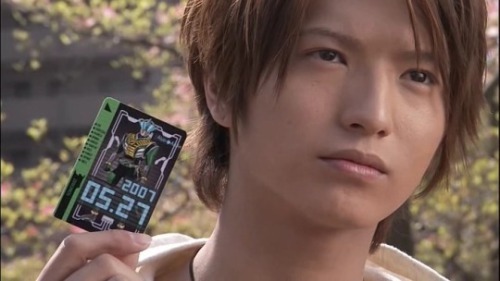
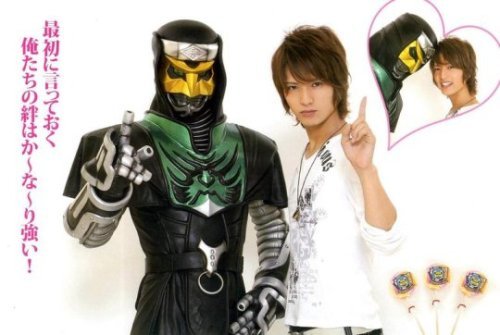
④ assigned to G-Star.Pro ( ジースター・プロ ) ⑤ has 2 Chihuahua ~Zero~ (Kamen Rider Zeronos) & ~Spica~ ↓ ↓ ↓ (Futatsu no Spica)

⑥ was part of Johnny’s Jr. (~2003)

⑦ had poor health as a child (asthma) [same here!!! in and out of the hospital] ⑧ loves reading shoujo-manga (ex: Good Morning Call グッドモーニング・コール / he had a cameo in the drama adaptation epi.15/16) and listening to jpop (Shounan no Kaze, Kis-My-Ft2, EXILE, CHEMISTRY, AAA ← friends with Nishijima Takahiro & Atae Shinjirou since ‘Delicious Gakuin’) ⑨ former member of a group of actors called D-Boys
as I talked about in one of my earlier posts… I really feel connected to Channaka and he kinda ‘helped’ me during the hardest time of my life. [check out my post about ‘Doukyuusei’ if you want to know why^^]
… when I heard he would be in the special unit called D☆DATE (together with Araki Hirofumi, Igarashi Shunji, Seto Koji & the new member Horii Arata) in 2010, I was so happy for him… because he deserved some more attention! He is one of the few boys who didn’t act in Tenimyu and that was really hard for him, because most of the D-Boys acted in it and became kind of “famous” for it.
In interviews he often talked about that he couldn’t get over the fact the he didn’t have a chance to be in Tenimyu and he couldn’t understand why, especially because he came out first at the 1st D-Boys audition.
And finally he got the attention he deserves, the most unthinkable thing ever happened. Right before his new stageplay (D-BOYS STAGE 2010 trial-2 ラストゲーム ) it was announced that he will take a break from work to cure his ‘chronicle back pain’. It was a huge shock for me because they announced it right before I moved to Japan. I still remember that I was sitting on my packed boxes in the livingroom when my friend called and told me the news…
almost a 1 year later we still had no real information about his condition… it was really depressing. I went to almost all D☆DATE events wearing orange things/stars (his member colour) and was even on TV (はなまるマーケット hanamaru market) with these ↓ ↓ ↓ uchiwas ↓ ↓ ↓ just to show that we were still waiting for him T^T


At the 1st Concert Tour of D☆DATE we finally got some ‘news’. They talked about him, said that it’s sad he couldn’t make it in time for the concert, but he would be trying his best to show up on stage again as soon as possible. I was crying while they showed pictures of him during the con because I felt so helpless.
After all the terrible things that happend in the first half of 2011 (the Fukushima-incident, the sudden death of my aunt, trouble with my former workplace…) I was kinda happy to hear that Channaka was still part of the group and the members where all waiting for his comeback!!! I thought that it would be only a matter of time until I could finally see him safe and sound on stage again… I was soooo motivated that I created a photo album with many pictures from fans all around the world to cheer him up and show him that soooooooooooo many people are waiting for him!!! I wrote the first fanletter (~8pages) of my life and told him that his fans would always support him and would wait for him as long as it would take for him to recover… and I wrote something that some fans would never understand… ‘If you wanna quit, don’t worry about us… we will respect your decision!!’ actually there is a reason why I wrote something like that…
I heard from a friend who worked as a model for Watanabe Enertainment, that he had no ‘back-pain-problems’ at all!!! He was suffering from depression… [he had a hard time in August 2010 and realised that he couldn’t perform with this unstable condition, so he stopped coming to rehearsal 2 weeks before the actual stage… I can understand that the other D-Boys member were not amused about it… but what I heard from my friend made me really sad: they started to bully Channaka and told him to quit… especially the D☆DATE members didn’t want him to come back!!!… from my experience with the industry in Japan, this is quite common (especially Johnny’s Enertainment) but I still find it hard to understand] ← I got this information from a friend, no official statement!!! + I don’t hate any D-Boys members… I’m just sad about the fact at all!!!
And than,on November 8th, 2011 (4 weeks after I handed out my letter & 2 weeks after my B-day) it was announced that he would retire from D☆DATE/D-Boys _| ̄|○ (I had never expected that this would happen… I cried a lot!! who would think that this little sentences in a little fanletter from a little foreign girl would come reality. I don’t believe that it was the trigger for his decision… but still… the timing… I was shocked) The ‘official’ statement was ‘in order to recover he needs to conentrate on rehabilation more’… but I couldn’t believe this anymore!!!
The following year Watanabe announced that he would completely retire from the entertainment world and I was crashed… I met soooo many people from the industry (not only because I went to a lot of events… my job gave me the opportunity to meet a lot of people in private) but the only person I ever wished to meet in Japan ‘disappeared’ and my chances to ever see him in person were almost 0…
And than in the beginning of 2013, he all of a sudden started his new blog where he posted pictures of him posing with friends (O_O) Rumors started to spread that he opened up a café/bakery with a friend (but I have no detailed information about that). I was so relieved that he was doing fine^^
AAAAAAAND 1½ years later the best thing ever happened!!!! August 30th, 2014: Nakamura Yuuichi returned to the entertainment industry. I was jumping up and down in my room, called my best friend (who isn’t even a fan at all笑) and poured my whole soul out^^
It took a while for him to come back on screen, but it was worth waiting for!!! The first role he represented after his comeback was ‘Sakurai Yuuto’ in ‘Superhero Taisen GP Kamen Rider 3 Gou’ (スーパーヒーロー大戦GP 仮面ライダー3号)
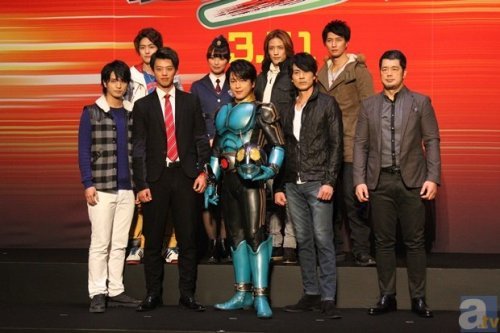
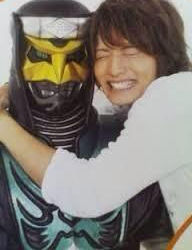
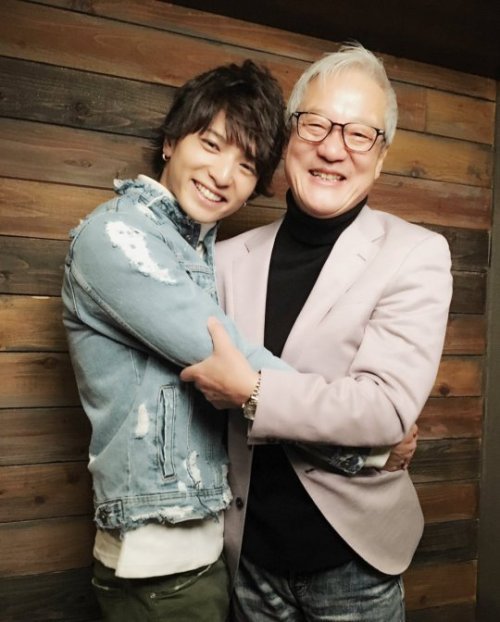
I think you get it by now… Kamen Rider Den-O (Sakurai Yuuto/Ootsuka Houchuu aka Denebe) means a lot to him!!! and if you are still not convinced… try to listen to the recording from ‘Kamen-Raji-Ranger 仮面ラジレンジャー’ I was at the venue when they recorded the show T^T aaaaaand just for the records…
this was the first time seeing him in person right in front of me!!!!!!!!!!!!! (August 18th, 2015 will go down in history^^) can you believe it… it took me almost 5 years to meet him (O_O)
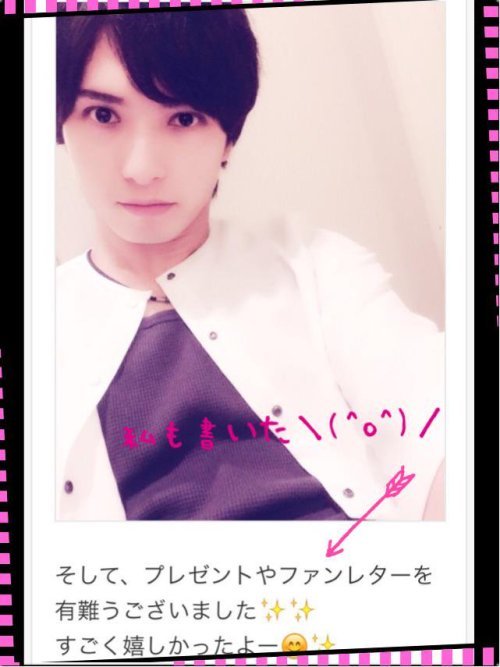
(the pic I posted on twitter after I saw his post^^)
since then he acted in soooo many great productions and had a few leading roles (薄桜鬼SSL ~sweet school life~ / 舞台 裁判長!ここは懲役4年でどうすか 2016 / スレイブメン / 舞台 警視庁抜刀課 / 舞台 BRAVE10/ 舞台版 ヘルプマン! ~監査編~ / 最後の晩ごはん)
Seeing him working this hard after all that happend in the past, I decided that I will follow and support him as a fan for the rest of my life笑 He will always be my №1 ♡
If you feel like supporting him or just got interested in him… here are some things I recommend:
① check out his: twitter official blog wikipedia
② (re-)watch Kamen Rider Den-O
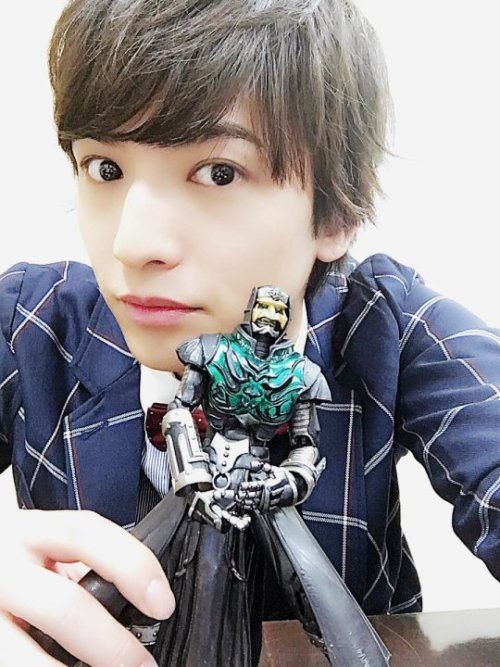
③ take a look at his photobooks^^

1st shashinshuu (2008)

2nd photobook (2010)

aaaand his new photobook (was released October 8th, 2017 to celebrate his 30th B-day)
④ if you want to get emotional… watch:
Doukyuusei [同級生] Futatsu no Spica [ふたつのスピカ] D-Boys Stage Vol.3: Karasu [10 D-BOYS STAGE vol.3「鴉~KARASU~」-10]
⑤ or consider buying any kind of media you might be interested in^^
if you made it to this point… thx for sticking along!!!! ♡ I would love to hear/read from you about your №1 and maybe some thoughts about Nakamura Yuuichi^^
and last but not least my best off Nakamura Yuuichi (more pics... sorry笑)
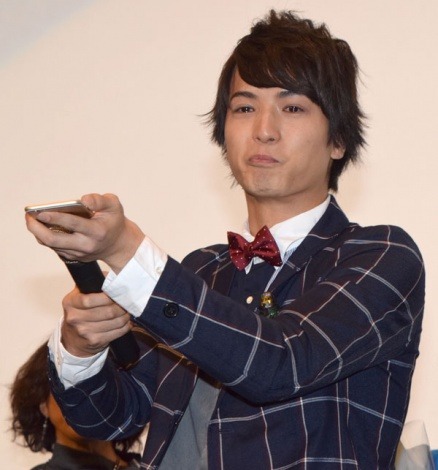




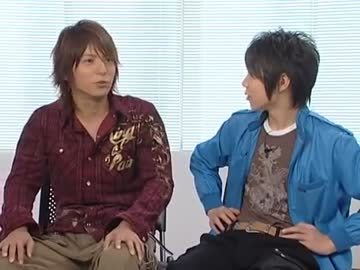



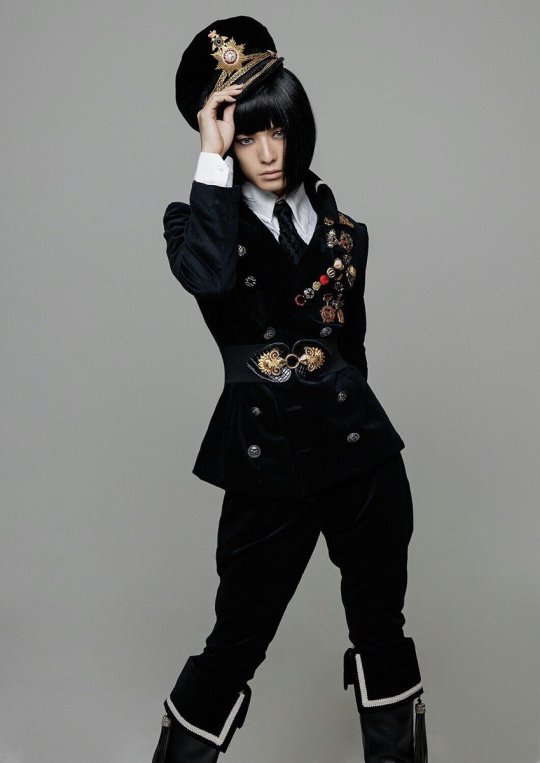










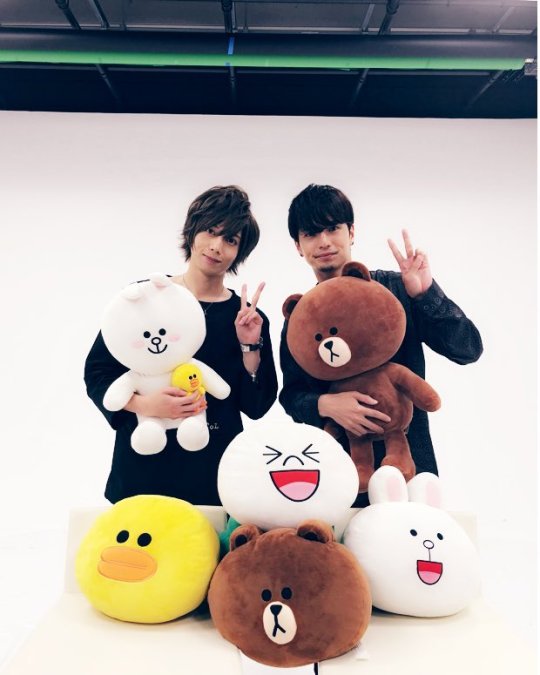


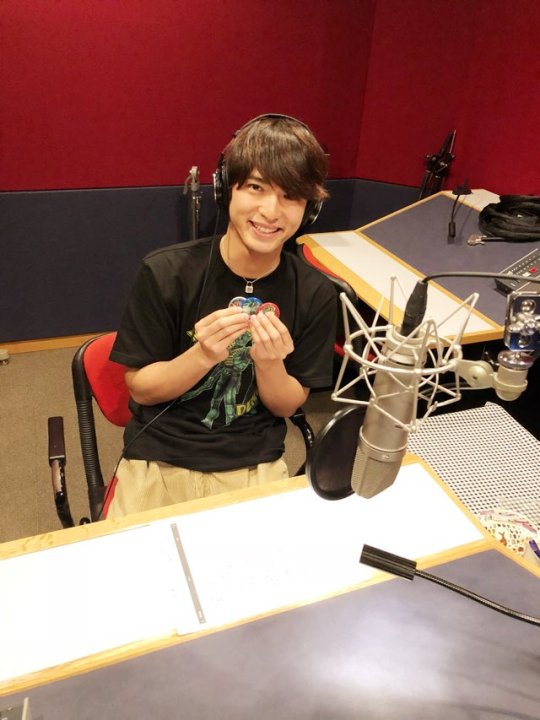




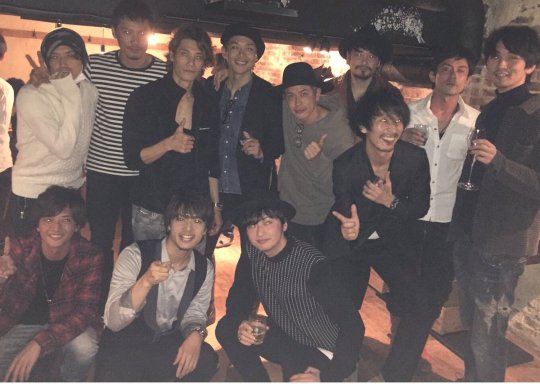





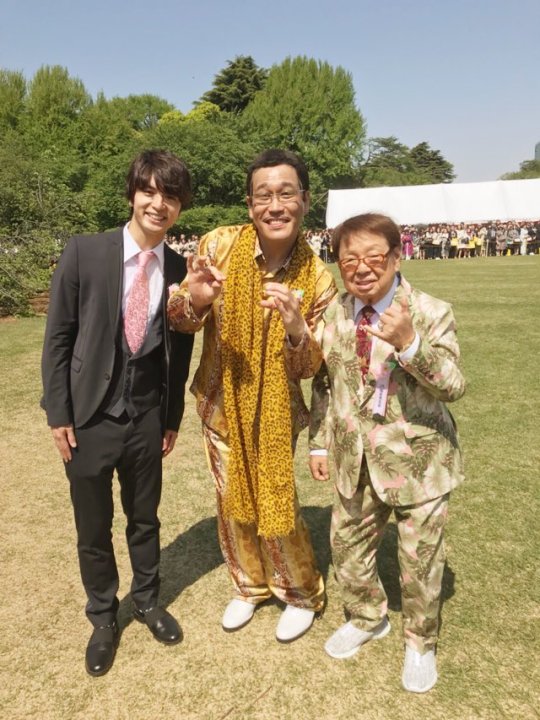

#中村優一#nakamura yuuichi#jactor#who is your favorite#just me being a fan#tell me about your №1#i would love to hear your thoughts
19 notes
·
View notes
Text
Who is Raffaello Follieri? Wiki, Biography, Age, Anne Hathaway's ex-Boyfriend, Instagram
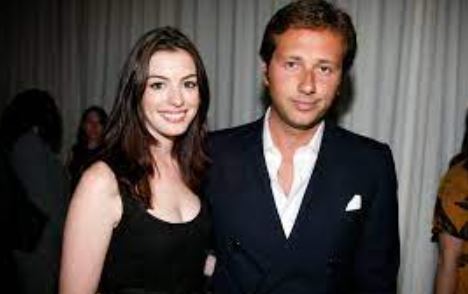
Raffaello Follieri Wiki - Raffaello Follieri Biography
Raffaello Follieri is Anne Hathaway's ex-boyfriend. He claims that she never spoke to him after he was arrested for fraud in 2008. Follieri spoke about their sudden separation in a new interview, saying that he "never" heard from the actress, who was dating at the time, once he was handcuffed. “That night Annie called me from Los Angeles where she was doing press,” he recalled to the Daily Mail. “We were on the phone for 10 minutes talking about when she could come home. If I remember correctly, Annie's last words were "I love you forever" and we ended the call. That was at 2 a.m. on June 24, 2008, ”he continued. “At 6 in the morning, they arrested me. I never spoke to Annie again. "Page Six has contacted the Hathaway representative for comment.
Raffaello Follieri Age
Raffaello Follieri's age is unknown.
Anne Hathaway said, she never spoke to him after he was arrested for fraud in 2008
For four years, and Anne Hathaway in love would tell anyone who would listen that her charismatic boyfriend Raffaello Follieri was "a god." Not only was he, she said effusively, "soooooooo", but the handsome Italian real estate developer treated her very similar to her fictional character in The Princess Diaries, the movie that she launched into her brilliant career when I was a teenager. She took it around the world on jets and yachts, spending £ 87,000 on a private plane for a New Year's Eve party at the home of fashion designer Oscar De La Renta in the Dominican Republic, where Bill and Hillary Clinton were also guests. There were suites at the Ritz in Paris, the Excelsior in Rome, the Dorchester in London, and God knows how many other luxurious hotels when they weren't in her opulent £ 30,000-a-month Manhattan apartment. Here, Follieri, who claimed to have close ties to the Vatican, entertained some of the richest people in the world while looking for investors to buy properties belonging to the Catholic Church. Hathaway was, most of the time, by her side. It was her, she says, a "fiery" relationship with passionate outbreaks, passionate makeups, and plenty of gifts, including stunning sapphire and diamond earrings, an emerald and pearl Cartier necklace, and a diamond topaz bracelet. Hathaway, in turn, gave her "acute" green plastic frog, the kind that in fairy tales she turns into a handsome prince when she kisses a princess. “She was 25 when we met . We spent many happy and happy moments. I thought nothing was the limit for me, "says Follieri, today, in this exclusive interview. 'I remember one night when Annie (her name for Hathaway) was filming in another country, I was in the apartment looking out of this amazing window and feeling like I could do anything. that I would like. Then, on June 24, 2008, Follieri was arrested for fraud. "That night Annie phoned me from Los Angeles, where she was doing Press ," he says. We were on the phone for ten minutes talking about when she could come home. "If I remember correctly, Annie's last words were 'I love you forever and we ended the call. That was at 2 am on June 24, 2008. At 6 am I was arrested. I never spoke to Annie again.". Follieri insists that he harbors no bitterness towards Hathaway, but the pain is written all over his face. Since his arrest, he has not had any communication from the woman he loved, not even a note of support as he "broke into a thousand pieces" in jail. "Never, never, never," he says. “I think she made a business decision. He decided that saving her career was the most important thing. I am not bitter. You can look me in the eye I don't have rage, but they have hurt me. " This is the first time that Follieri has spoken openly about what would become known as the Vati-Con scandal. Following his arrest, court documents show that prosecutors claimed that Follieri lied about his ties to the Vatican. They said he claimed that top church officials had authorized him to represent the Catholic Church in the US while he was buying churches and monasteries. Investors' money, most notably Ron Burkle, the private equity billionaire best known for his close personal friendship with former President Clinton, was then used, prosecutors said, to finance the lavish lifestyle that Follieri led. with his famous girlfriend. In addition to the jets and yachts, his company's expense account paid for expensive meals, flowers, medical expenses for him, his parents, and Hathaway, and an elite dog-walking service for Esmeralda, the brown lab. partner. Later, Follieri would admit 14 counts of wire fraud, money laundering, and conspiracy in a New York court as part of a settlement reached with prosecutors. He really had no choice. Had the case gone to trial, he would face a possible 160-year sentence. Read Also: Who is Jennifer Emmi? Wiki, Biography, Age, Family, Charged, Arrested, Investigation Instead, he was jailed for four and a half years. Following his release, he was deported to Italy and remains unable to enter the United States. "One day I was in the Olympic Tower and the next in solitary confinement in a cell in New York," says Follieri. "You can absolutely say that I flew too close to the sun." When you are young, you try to do things quickly. I was 20 years old. I was superficial. I made mistakes. “For example, the first part of the trip to the Dominican Republic when we went to Oscar de la Renta's New Year's party was on business. I was with the Cardinal of Santo Domingo. I was wrong because I mixed business with pleasure and invited some friends. “It should have been detected when the budgets were approved, not years later when the money was already spent. "But, as you know, I pleaded guilty to my crime and paid a lot for my mistakes." Now 43, Follieri has, as he puts it, 'more gray hair and a few kilos more' than the dark-haired 'god'. who was photographed at endless parties with Hathaway. He is now happily married to Konstantina, a friend from New York who stood by his side during his years in prison. They have homes in Milan and Athens, a four-year-old son, Pasquale, and they expect a daughter any day. "If there's something positive that has come out of this, it's understanding that you need to have the right person by your side, someone you trust. I trusted the wrong people. Konstantina came to see me during the four years. My wife is a person at heart. She really cares about me, not what I have or what I can afford. If she tomorrow she decided to go and live a simple life, she would be fine with that. “But now I keep my business and private assets very separate. If I rent a jet for personal use, I pay for it myself. I live the life that my private resources allow me to live. Boat rental. I love sailing, there is something magical about it. Do you want to condemn me for that? Today, Follieri could afford to write a check for a fleet of luxury yachts if he so desired. He has built a new business empire that overshadows his ambitions in those heady Hathaway days. His company, Follieri Energy, has assets that include 162 service stations, worth more than £ 150 million. His parent company, FHolding UAE, with his other subsidiaries, is worth God knows how much. "The rebuilding was not easy. I kept in touch with people I had met in the United States. We had a meeting in London where we discussed business. They introduced me to contacts in Saudi Arabia. They knew what had happened and they trusted me." Right now, Follieri is considering investing £ 200 million of venture capital in the UK to develop a chain of green service stations. They will be a percentage of traditional carbon fuel and 50% of green energy, such as hydrogen and electric charge. Each will be self-sufficient, with solar panels on the roof, '' he says, his eyes shining with the passion that won this once-faithful Catholic boy from Foggia, southern Italy, Hathaway's love and an entrance to the interior of Bill Clinton. circle. Follieri lost her faith in jail, but many of the powerful men she once socialized with remain friends, such as Tony Podesta, brother of Bill Clinton's former chief of staff John Podesta, who is president of FHolding UAE. He describes Follieri as "a true visionary." Follieri, an only child whose father was a lawyer with connections in industry, banking and the Vatican, was 23 years old and was jogging near his Rome apartment when the idea of buying real estate for the church took hold. The Church sold property to compensate victims after the pedophile priest scandal. Follieri had church connections: His friend Andrea Sodano was the nephew of Cardinal Angelo Sodano, who, under the ailing Pope John Paul II, essentially ran the Vatican as secretary of state. “Local developers were buying properties in Manhattan and Los Angeles, but most of the properties were in the middle of nowhere with little real estate value. The Follieri Group was the first real estate fund to purchase church properties globally. "Andrea was my partner and vice president, so he had direct access to the Vatican." Within a few months of moving to Manhattan, Follieri began to land a lucrative investment. He was introduced to Hathaway in 2004. "I was having dinner with friends," he says. "A Swedish friend asked, 'Can I invite this girlfriend of mine? "I didn't know about Annie's movies, I wasn't watching the movies she was in: The Princess Diaries. She was just a good girl who made a really good impression. 'We were young. I was 25. She was 21. years. I invited her to lunch but I was late. I sent her roses to apologize, I think that night, "she laughs softly." It was a relationship that worked immediately. As Follieri's fund grew and Hathaway's career went from strength to strength, their love blossomed. So did Follieri's overspending: offices at 350 Park Avenue, the five-bedroom apartment at Olympic Tower, the private jet to the Michael Jordan Golf Tournament in the Bahamas where, again, Bill Clinton was invited, a superyacht in the Mediterranean. , another in the Adriatic. Over and over it happened. In fact, the week before 15 FBI agents arrived at his parents' apartment in Trump Tower, where he was staying that night, Follieri was in Capri, the playground of the rich and famous, finalizing arrangements for his 30 birthday at the exclusive Da Paolino on the island restaurant. When the bell rang, my mother answered. That's what I regret the most: that she was in the house when I was arrested. My mother has been to hell and she has come back for me. '' Follieri was handcuffed and taken to federal court in New York, where the charges against him were read. The bail was set at an astronomical £ 17 million. Follieri collapsed. "I couldn't breathe. I felt really bad. They took me to the hospital and, around midnight, they took me to prison, to solitary confinement . 'That's when it hit me hard. I was trying to understand what was happening to me - someone who never had a parking ticket in his life. '' Raffaello's inability to understand his arrest stems from the fact that charges of wasting investors' money had been issued for more than a year. a year earlier, in a civil lawsuit brought against Follieri by his billionaire investor, Ron Burkle. That lawsuit was settled and Follieri paid £ 1 million. However, two allegations remained: that Follieri had transferred sums of money totaling hundreds of thousands of dollars to a bank account in Monaco, and that he had lied about his connections to the Vatican, with some alleging that he claimed be the CFO. Follieri does not pretend to be a saint. He acknowledges that he was careless, arrogant and fiery. But some scratched their heads as to why the authorities criticized him so much. Follieri cannot discuss the charges as part of his plea deal, but he says, “I am not a criminal. Real estate is competitive and lucrative. My business was very successful. We had acquired large properties throughout the United States. “I accomplished a lot at a young age. Most get there when they are 50 or 60 years old. I think a lot of people didn't like that. "I was too big. I had too much, too soon, and since Annie and I were dating, I got noticed. I think the publicity sparked interest in me." The reality was that Hathaway's 'god' he had no chance of raising his £ 17 million bail, so he was transported from New York court in chains. "Like some kind of animal, they left me below 10 degrees in the cold in a T-shirt and a pair plastic pants, "he says." I stopped eating, probably for eight days. It was a dark time. "If she had wanted to contact me, she knew how to communicate with me through my family and friends." She did not do it. “We had been fighting a lot, as many couples do, but we were still in a relationship. He was broken into a thousand pieces. “I was at the bottom, but, at one point, I thought, 'This is not fair to my parents. I'm going to get over this. "My mother helped me. Every month for four years, she flew from Italy to New York and took a train to where I was to see me." Raffaello was transferred to four different prisons during his incarceration. "The detention center in Brooklyn was the most difficult," he says. “There were 120 people in a room with two bathrooms. Excrement in the showers. It was terrible, terrible, with rats under the beds. The food they gave us was so rotten that I got sick. That's where my religion left me a bit. Some say it's what God puts us through to test us, but I don't see it that way. I still believe in God, but I stay out of the church. " When Follieri came out of jail in nothing but a sweatshirt and the sweatpants he was wearing, he weighed more than two kilos less than when he entered. Since then he has needed surgery to remove his gallbladder and suffers from insomnia. "I did not sleep because you are always alert for something to happen, for someone to come for you, so you have to be prepared. That stays with me. I sleep very little, three or four hours at the most. "You know how people say," Oh, everything happens in life "? He shakes his head." Everything that happened will stay with me forever. It doesn't matter how much business I do, how many ships I buy, or how many planes, those years. prison is always there. You just have to learn to live with it and learn from it. And you learn. Being on the plane back to Italy was the best feeling of my life, better than being in the Olympic Tower on the 47th floor because it was freedom. My parents met me at the airport. We drove for three hours to Rome, where my mother had organized a big lunch. I had not eaten for a long time. "A few weeks later, Konstantina came to spend time with me and never left. So that's it, my life started again. " FOLLOW US ON FACEBOOK Read the full article
#RaffaelloFollieri#RaffaelloFollieriage#RaffaelloFollieriarrested#RaffaelloFollieribio#RaffaelloFollieriexgirlfriend#RaffaelloFollierifamily#RaffaelloFollieriimage#RaffaelloFollieriinvestigation#RaffaelloFollierimanymorefactsyouneedtoknow#RaffaelloFollierispouse#RaffaelloFollieristatement#RaffaelloFollieriwiki#whoisRaffaelloFollieri
0 notes
Text
INTERVIEW: ODDTAXI Voice Actors Riho Iida and Ryohei Kimura

As ODDTAXI's final episode aired this week, to commemorate the occasion, we have something special to share with you all! Ryohei Kimura and Riho Iida, the voice actors for Dr. Goriki and nurse Shirakawa, respectively, were kind enough to answer a few questions about their experiences working on the anime. Check out our interview where we get their thoughts and fond memories of acting and performing in ODDTAXI and in the entertainment industry, as well!
First, we have some general questions for both of you. How did knowing that you were voicing a gorilla and alpaca, respectively, play into how you acted out your role?
Ryohei Kimura: I thought there must be some reason I was offered the role of Goriki, so rather than putting on an elaborate performance, I preserved my own personal acting style and personality.
Riho Iida: I actually haven't seen many alpacas. Alpacas seem to appear frequently in the anime series I'm in, but I haven't actually seen many.
By the way, my favorite animal is ... white tigers, I guess? I like white tigers. I don't think there was one in the series — or was there? I don't think there were any white tigers, certainly not in the main cast. There was a [polar] bear. I like big heavy animals like white tigers.
What drew each of you to the project and how has working on this show differed from other anime you’ve previously worked on?
Kimura: It's a high-quality suspenseful drama hidden behind unconventional character designs and casting choices. There's a lot of clever comedy mixed in, too.
Iida: There are a lot of things about ODDTAXI that are different from other series. The most obvious example would be when a character's mouth opens, they produce an "ah" sound of realization, or grunts associated with motion are included, but ODDTAXI eliminates a lot of those sound effects. It's true to life. We only included the sounds you'd make in real life. I think that's pretty different.

Now we have some questions for Kimura-san. What do you believe is Goriki's charm?
Kimura: He's an intelligent and magnanimous man who cares deeply for his friends. He feels very human in both good and bad ways, which I actually find charming.
You have been voice acting since you were 15, with Medabots being your earliest voice acting role. Is there any advice you would give to an aspiring voice actor that you have learned during your illustrious 20+ year career?
Kimura: As an actor, I believe exposing myself to and enjoying many series has been incredibly powerful. I'm sure you'll find it worthwhile, too.
While Goriki is definitely a supporting character in ODDTAXI, I can honestly say every scene with Goriki is memorable, particularly the Bruce Springsteen bit. How do you make sure you make the most out of any voice acting role, large or small?
Kimura: As part of producing a series, voice actors portray a character through only their acting, without their own appearance ever being highlighted. I'm able to put on performances that would be difficult to pull off in live-action and play characters that look vastly different from myself.

Now we have some questions for Iida-san. What did you do to prepare for the role of Shirakawa?
Iida: Shirakawa looks like a 28-year-old woman. When I recorded this role, I was basically the same age. I think my voice sounded neither like a woman older than 30 years old, nor like a woman in her early 20s. It was calm, mild, and also mysterious.
But since she's the heroine, I wanted to make her a little cute. Since the role's age was close to my own, there wasn't too much of a difference. But when I began recording, I found that I was stuck on the idea of putting on a "performance by an anime voice actor," so the first day involved a lot of discussions, retakes, and trial and error.
Is there anything you paid special attention to while acting this role?
Iida: We'd discussed in meetings that the acting should sound as natural as possible. Throughout the recording process, I focused on speaking flatly and naturally, as though speaking to the person sitting next to me, in a way I'd normally speak. That was the direction I received, so I did my best to follow it as closely as possible.
As a childhood star, you’re clearly no stranger to the acting space. How has a career in voice acting positively changed your career?
Iida: I've been in the entertainment industry for 21 years now. For half that time, I worked as a child performer as an actor and entertainer. At exactly the halfway mark, I started working as a voice actor. I felt like I couldn't do just one thing in my career. I've seen so many sights and gained so much knowledge. I've been influenced by the expansiveness of the world of expression.
Shirakawa and Odokawa’s chemistry in the show is very interesting. What do you think about Odokawa and Shirakawa’s relationship? What do you think Shirakawa sees in Odokawa that he fails to see in himself?
Iida: I'm not sure! It'll take a little extra effort for their relationship to become romantic. It's complicated. Neither of them is the type to directly communicate their feelings. Their conversations tend to take an indirect path. Personally, since Shirakawa says she likes Odokawa-san, I think it would be nice if they got together, but I'm not sure it'll be easy. Their relationship is uncertain.

My favorite scene in ODDTAXI is when Shirakawa begins to practice capoeira in the park, which I thought was very funny. Did you do anything special for that scene or do you have any other unique experiences while working on ODDTAXI?
Iida: I personally had heard the term capoeira, but I didn't know what it was or what sounds people made while doing it or when it was used. I found videos online of people doing capoeira and listened to them in very quiet places to hear the noises people made. It was interesting. I wasn't expecting to do any capoeira.
Shirakawa-san has a moment in which she explodes on Odokawa-san inside his taxi. Personally, I enjoyed her conversations with him. They were fun.
Now having done both acting in live-action as well as voice-acting on several successful anime, what other opportunities are you looking forward to next?
Iida: I'd like to play a villain. A strong woman who fights. Shirakawa-san is demure and mysterious, even though she practiced capoeira. I think people's impression of me would change if I played a strong-willed woman who can go toe-to-toe with the men. Also, I'd like to try playing a mom. I bet it would be fun to play a loving mother.
Is there any kind of work you'd like to try in the future?
Iida: Our perspective has really broadened in this day and age. People are able to try all kinds of things. Even people who don't belong to an agency are getting work, and young people are starting their own companies. I've been in the industry for 20 years. Like I mentioned in a previous question, I spent 10 years as an entertainer and 10 years as a voice actor. By the time my career is 30 years old, I'd like to have done something new and broadened my horizons. There are new things I'd like to try, but I also hope I exceed expectations on the work I receive.

Alex enjoys watching and writing about anime and is always looking for new shows to binge. Follow him and give your suggestions of what to watch next on Twitter at @alexkpan.
Do you love writing? Do you love anime? If you have an idea for a features story, pitch it to Crunchyroll Features!
By: Alex Pan
0 notes
Text
Dallas through the Looking Glass: Post-Truth and Kennedy Assassination Movies by Chris Evangelista

Here’s an alarming statistic: a recent CBS News poll revealed 74% of Republican voters believe the conspiracy theory that the offices of Donald Trump were wiretapped during the 2016 presidential campaign, despite there being absolutely no evidence to support that claim. But conspiracy theories are easy to grasp onto. Another poll, this one by Fairleigh Dickinson University, says 63% percent of American voters believe in “at least one political conspiracy theory.” There’s a strange comfort in believing a conspiracy—a sense that you are in the know, while others are on the outside looking in; that you, and a select few others, have discovered the truth, while everyone else is still in the dark.
Conspiracy theories surrounding presidents are nothing new. The wiretapping conspiracy theory, however, had the unlikely distinction of being made popular by the president himself, via Mr. Trump’s serially inaccurate Twitter feed. Trump himself has made his entire political career about conspiracy theories: his current ascendance in the world of politics, for instance, owes something to his leadership of the “Birther” movement—the not-so-thinly veiled racist belief that President Barack Obama is not an American citizen. At the time, Trump and his hateful ilk were on the fringe. Now they’re running the country. Welcome to the post-truth era. Welcome to the world of “alternative facts.”
Shortly after the startling 2016 presidential election, the Oxford Dictionaries selected “post-truth” as the international word of the year. The term is defined as “relating to or denoting circumstances in which objective facts are less influential in shaping public opinion than appeals to emotion and personal belief.” Yet this post-truth way of thinking is nothing new—rather, it has finally gone from existing somewhere on the fringes to playing a role in the mainstream. Perhaps the most overwhelming source of post-truth logic had been in plain sight for the last 53 years, in the conspiracy buff movement that has studied and dissected the November 22, 1963 assassination of President John F. Kennedy. And, as is the case with any event that shocks the world, it was only a matter of time before art attempted to make sense of reality.
In 1973, ten years after JFK’s assassination, Executive Action found its way into theaters, starring Burt Lancaster, with a script by Dalton Trumbo. Imagine if in 2011 a film about 9/11 being an inside job written by Aaron Sorkin and starring Tom Hanks had been released, and you might have some concept of how startling Executive Action likely seemed. Here was a no-nonsense thriller, inter-spliced with actual newsreel footage of Kennedy, concerning a shadowy cabal of businessmen who make up their minds to murder the president. They have their reasons: Kennedy pulling out of Vietnam will be bad; Kennedy’s support of civil rights will lead to a “black revolution”; Kennedy is taking the country in a distressingly “liberal” direction. What are a group of businessmen, oil tycoons, and ex-US intelligence members to do but put together a very intricate, somewhat convoluted plot to kill JFK and frame a hapless patsy, Lee Harvey Oswald?
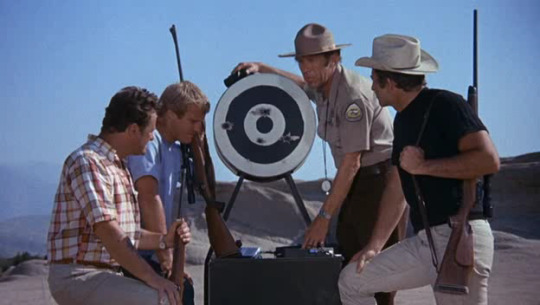
Executive Action was the brainchild of attorney and conspiracy buff Mark Lane, who wrote multiple books on the assassination. (Although rumor has it that it was actor Donald Sutherland who came up with the idea first, and tasked Lane with writing a script for him to star in.) Director David Miller’s approach to the script is workmanlike: lots of medium shots, lots of by-the-numbers blocking. No frills. But there is an undeniable effectiveness to the film, mostly in how calmly everything is handled. When you contrast this film with Oliver Stone’s JFK (more on that later), which tells almost the same story, it’s night and day. Stone’s film is frantic, unhinged, to the point that you can almost see the perforations as the film shakes off the reels. Executive Action is cold, businesslike, much like the men who nonchalantly plan to kill the most powerful man in the world. Lancaster, with his clipped cadence, has never been so chilling. He has a simple job—hire men to kill JFK—and he does it the way any everyman might approach a difficult but not impossible task. There’s no drama, no wringing of hands, no moral conundrum. It makes Executive Action all the more believable. Everyone is so calm and collected here that you can’t help but think, “Well, maybe this is how it happened.” (It’s not.)
On the heels of Executive Action came Alan J. Pakula’s darkness-drenched The Parallax View. Parallax isn’t a direct take on the Kennedy assassination, but the implications are unmistakable. Once again, we have a group of shadowy captains of industry pulling the strings behind the scenes. Once again, we have an unfortunate patsy set up to take the fall for a political assassination. Notice a thread here: a lone gunman is framed and blamed. An angry lone nut takes the fall while the real killers go unnoticed, or worse—remain in power, unstoppable. So disillusioned were the American people by both JFK’s death and Watergate that it was easy to believe the forces of darkness were calling the shots.
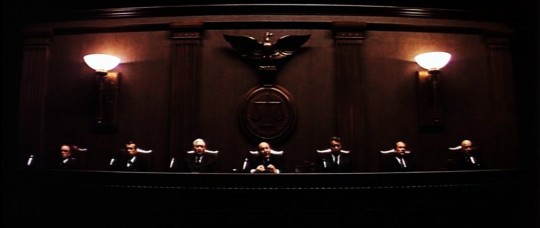
The bulk of narrative films that address the Kennedy assassination almost all revolve around the assumption that the official story—Lee Harvey Oswald acted alone—was bunk. After all, who was Oswald? A nobody. A scrawny runt with dyslexia. How could one insignificant man alter the course of history? At the same time, why isn’t it more believable that a man with an unstable personality carried out the Kennedy assassination, rather than a multi-tiered, far-reaching conspiracy of shadowy men in smoke-filled rooms? The real Lee Harvey Oswald was a controlling abuser—a man who beat his Russian wife and insisted she never learn English so that he would be her only point of contact in America; a man who resented any and all authority; and a man who, months before the assassination, in April, actually attempted to carry out another assassination of notorious John Birch Society member Major Edwin Walker (an event most conspiracy films never even mention).
If there is one film that conspiracy lore owes the most debt to, it’s Oliver Stone’s 1991 blockbuster JFK. A meticulously crafted, downright brilliant thriller, JFK blends fact and fiction so deftly that one could be forgiven for thinking the film was more of a history lesson than a piece of pop entertainment. Stone, for his part, did very little to clarify what his intentions were. He said in an interview with the New York Times that “every point, every argument, every detail in the movie...has been researched, can be documented, and is justified.” Stone also claimed the film was a “history lesson” and that he was “trying to reshape the world through movies.” Stone also dubbed himself a “cinematic historian” during promotion for the film. Years later, in Matt Zoller Seitz’s expansive The Oliver Stone Experience, Stone had changed his tune slightly: “I don’t call myself a historian. I call myself a dramatist.” In Seitz’s book, Stone seems to downplay the “every detail can be justified” claim and fall back on his speculative fiction angle, although he’s still clearly convinced of a conspiracy.
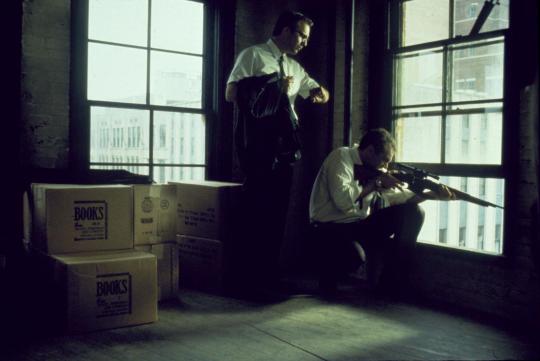
As a work of fiction, JFK is a masterpiece. Stone, a team of editors, and cinematographer Robert Richardson create an immersive trip through the wild world of JFK conspiracy lore. Stone needed a hero to center the film’s sweaty, paranoid ramblings, and he found it in New Orleans District Attorney Jim Garrison. As played by Kevin Costner, Stone’s Garrison is a Capra-esque hero, a truth seeker committed to doing the right thing, no matter what the cost. “Let justice be done though the heavens fall!” Garrison trumpets to a team of reporters. JFK has Garrison cracking open the Kennedy case by first looking into the time Lee Harvey Oswald (played with eerie chameleon-like fervor by Gary Oldman) spent in New Orleans, and then cracking open the whole can of worms. Oswald, Garrison learns, is just what he said he was—a patsy. The real killers of Kennedy were the military industrial complex, or maybe the FBI, or maybe the CIA, or maybe the mafia. Or maybe…. well, the list goes on. Despite Stone’s claims at the time of the film being a history lesson, he never presents an entirely concrete connection between any of these conspirators.
The first half of JFK sets up the pieces: here is who may have been involved with the assassination and we’re not sure how all these people fit together, but one thing we know for sure is that Oswald didn’t pull the trigger. The back end of the film turns into a courtroom melodrama, with Garrison bringing local New Orleans businessman Clay Shaw (played with a chilly sophistication by Tommy Lee Jones) to trial for being one of the lead instigators of the assassination plot. Eventually, Shaw is found innocent, and rightfully so—the film presents almost no real evidence to prove Shaw had anything to do with the alleged conspiracy, save for the testimony of a male prostitute, Willie O’Keefe (Kevin Bacon, having the time of his life). Here is where a moral conundrum arises: Clay Shaw was a real person, and really was brought to trial by Garrison. Willie O’Keefe is fictional, a character inspired by a man named Perry Russo. The problem: Russo was so undependable as a witness, his credibility so suspect, and his story so inconsistent, that Stone had to create a fictional character in order to get the story he wanted.
There are more problems with Stone’s approach. The real Jim Garrison was not the crusader for truth the film makes him out to be. The historical Garrison was actually a man who would’ve fit right in with the Trump administration. “Most of the time you marshal the facts, then deduce your theories,” said former First Assistant D.A. and Garrison associate Charles Ward. “But Garrison deduced a theory, then he marshaled his facts. And if the facts didn’t fit he’d say they had been altered by the CIA.” Garrison, for his part, even doubled down on this backwards logic, stating at one point, “The district attorney can make any statements he wishes,” truth be damned. Whatever evidence Garrison lacked, he seems to have fabricated. Most considered his bringing Shaw to trial a miscarriage of justice, and after Shaw was swiftly acquitted, Garrison mostly languished in obscurity. Even the conspiracy buffs distanced themselves from him. Then Stone, and Hollywood, came calling, and Garrison was back in the limelight.

If you’re able to remove the historical elements from JFK, you can easily enjoy it. But when you start to dissect the truth, or at least what’s known of the truth, the waters get murky. JFK’s Oswald is presented as an innocent bystander, unaware of the dark forces working behind the scenes to set him up for the biggest murder in American history. In one wisely deleted scene from the film, Stone even had the ghost of Oswald take the stand during the Shaw trial and flat-out proclaim, “I am innocent!” Vincent Bugliosi’s gargantuan Reclaiming History: The Assassination of President John F. Kennedy is one of the most definitive books written on the Kennedy assassination, and Mr. Bugliosi lays out page after page of evidence that points to Oswald’s guilt—evidence that’s either never touched on or outright altered in Stone’s film. Stone completely ignores the incident where Oswald, using the same gun that was proven to have killed Kennedy, attempted to kill Major Edwin Walker. The film also casually omits the fact that the morning of the assassination, Oswald received a ride to work from a coworker who claimed Oswald had a long, wrapped package with him. Oswald claimed the package was just “some curtain rods”—though why he was bringing curtain rods to work was a mystery. Also a mystery: after Oswald was arrested, he denied bringing any curtain rods. Later, the brown wrapping paper the “curtain rods” were wrapped in was found on the sixth floor of the Texas School Book Depository, where the shooting allegedly took place. So either Oswald really did bring curtain rods to work, unwrapped them, and then they mysterious vanished, or what he actually had was his rifle. Or perhaps the coworker was lying and in on the conspiracy.
Other casually omitted or altered facts from Stone’s film: during the assassination, a man named Howard Brennan looked up and saw Oswald in a window of the book depository, rifle in hand. Later, as Oswald fled the crime scene, he was believed to have shot and killed Officer J.D. Tippet. Stone’s film presents a scenario in which no one was able to identify Oswald as the shooter of Tippet, when in fact there were ten separate eyewitnesses who placed Oswald at the scene. The list goes on and on. The argument could be made that art has no obligation to the truth. Dramatic license is the bedrock of most biopics and “true story” films. But this is a gray area when it comes to JFK, a film with weighted dialogue like “Fundamentally, people are suckers for the truth. And the truth is on your side.” On top of this, JFK has the distinction of bringing about legislative changes. So popular was Stone’s film that Congress passed the President John F. Kennedy Assassination Records Collection Act of 1992, which established the collection of all U.S. records regarding the Kennedy assassination to be housed in the National Archives. All of this, coupled with the film’s newsreel opening, lends an air of legitimacy to JFK. It turns speculation into perceived truth, intentional or not.
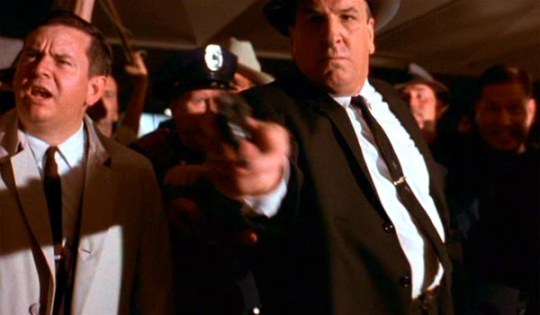
The year following JFK saw the release of Ruby, a film so far removed from historical fact that you’d be hard pressed to find anything true within its plot. Danny Aiello gives Oswald’s killer Jack Ruby a dignity the real Ruby never had, and turns him into something of a folk hero—a man who, like Stone’s Garrison, is committed to doing the right thing. Ruby borders on spy-thriller territory, with Ruby being drafted as a mafia hitman who gets wrapped up in a conspiracy spinning out of control. It’s mostly forgotten, and for good reason. Aside from Aiello’s soulful take on the Dallas nightclub owner, the film is unremarkable. 1993 gave audiences In the Line of Fire, where the Kennedy assassination haunts an aging Secret Service agent (played by Clint Eastwood) who was there that day in Dallas and failed to save Kennedy’s life. In the Line of Fire eschews conspiracy trappings but once again delegates Oswald to a footnote, an afterthought. In the film, a lone nut (played memorably by John Malkovich as something of an inhuman trickster) taunts Eastwood’s Secret Service agent with his plot against the current president via threatening phone calls. “Call me Booth,” Malkovich instructs Eastwood. “Why not Oswald?” Eastwood asks. “Because Booth had flair, panache,” replies Malkovich. “A leap to the stage after he shot Lincoln.” Oswald just isn’t dramatic enough for this assassin to emulate—and then again, maybe he was innocent?
2002’s Interview With the Assassin is an unjustly overlooked, highly creative take on conspiracy lore. Told in faux documentary style, the film follows an amateur filmmaker (Dylan Haggerty) approached by his elderly next door neighbor (a creepy yet hilarious Raymond J. Barry). The neighbor has a story to tell: it was he, not Lee Harvey Oswald, who delivered the fatal JFK head shot. As the filmmaker follows the alleged assassin, he first comes to believe the man’s story, then begins to have his doubts, convinced that the neighbor is just a deranged nut, before coming back around to belief for the film’s conclusion, all while the specters of shadowy government agents lurk in the background. Again, just as Executive Action and JFK deployed documentary-style footage to lend an air of legitimacy to their narratives, Interview with the Assassin is deceptively plausible. In fact, if you were unfamiliar with Raymond J. Barry, a great character actor with 114 screen credits to his name, you might actually fall into the Blair Witch Project trap and believe this really is a documentary, so believable and convincing is Barry’s performance.

As the 21st century progressed, the filmic approach to the Kennedy assassination shifted. Conspiracy began to take a back seat to attempts at “setting the record straight.” Perhaps in the specter of 9/11, with its “inside job” nuts coming out of the woodwork to proclaim, “Jet fuel doesn’t melt steel beams!”, or in light of the deplorable “Sandy Hook truthers,” who have the unmitigated gall to claim the murder of 20 children was a “false flag,” Hollywood has lost its taste for propping up conspiracies. 2013’s Parkland told a Short Cuts-like story of the minutes and hours following the assassination: From the team of doctors who valiantly but fruitlessly tried to save JFK’s life to a befuddled Abraham Zapruder (Paul Giamatti) coming to terms with the fact that by filming the head shot he’s now in possession of the most important “home movie” in history to Robert Oswald (James Badge Dale), whose entire life is suddenly upended by his estranged brother Lee (Jeremy Strong). Parkland doesn’t delve into the investigation, but makes it clear it believes Oswald is the sole killer. The film is curiously flat, failing to hit any of the big emotional beats it strives for. Where it succeeds is in taking the time to show the blood and confusion inside the Parkland hospital emergency room, and it does highlight the surreal occurrence of Oswald being wheeled into the same hospital with his own fatal wound so soon after the assassination.
Oddly, the most historically accurate portrayal of the assassination, and the events leading up to it, can be found in a work of science fiction. The Hulu mini-series adaptation of Stephen King’s 11.22.63 draws on King’s meticulous research into Oswald, and shows Oswald’s tumultuous, abusive marriage as well as his failed assassination attempt on Edwin Walker. It also shows him pulling the trigger. The twist in this whole narrative is that this is a time travel story, about a 21st century English teacher (James Franco) who goes back in time to try to stop Oswald. Franco’s character can only travel to 1960, and thus has to wait it out till 1963. He can’t just outright kill Oswald, though, because the doubt remains: what if Oswald really is innocent? As a result, 11.22.63 becomes a detective story, with Franco’s time traveller trying to piece together evidence to prove beyond a reasonable doubt that Oswald really is going to kill JFK, and then stop him. Of all the JFK films, 11.22.63 is the first to truly represent how unpleasant and abusive Lee Harvey Oswald was. As played by Daniel Webber, Oswald is a cruel jerk with delusions of grandeur, convinced he’s destined for greater things if only everyone would just get out of his way. This is closest to the real Oswald, based on the testimony of those who knew him, including his wife Marina. At one point, the real Oswald even boasted that one day he’d obtain the non-existent office of “Prime Minister of America.” The Oswald in 11.22.63 is an entirely different species than the sainted black-and-white ghost who takes the stand in JFK and proclaims his innocence.
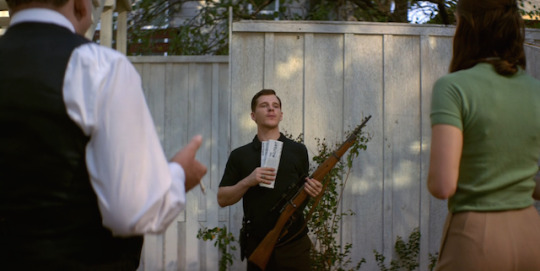
Pablo Larraín’s recent Jackie took the assassination narrative further than any film before it by dealing directly with the effect it had on both the nation and Kennedy’s widow (Natalie Portman). Jackie is obsessed with myth making, and much like the myths and conspiracies that sprung up in the years following JFK’s death, the film is awash in events that bend the truth and stagger the mind. A numbing effect sets in, as grief gives way to acceptance and some attempt at understanding. As doctors perform an autopsy on her husband at Bethesda Naval Hospital, Jackie, her pink dress stained with blood and gore, paces around the emergency room in a fury. “It had to be some silly little communist,” she spits as word of Oswald’s arrest for the murder spreads. “If [Jack had] been killed for civil rights, at least then it would have meant something, you know?” This line of dialogue from Noah Oppenheim’s script gets to the heart of the conspiracy movement: perhaps if the reasoning behind Kennedy’s murder had been some grander scheme instead of the actions of a lone gunman grasping at fame, then maybe there would be more meaning behind all of this. Maybe then life wouldn’t be so arbitrary, so random.
Jackie plans her husband’s funeral as pageantry; it’s not just a somber service, it’s a Hollywood remake of Abraham Lincoln’s funeral, with a march through wintry streets as all the world is watching. Following the funeral, she tells her story to a reporter (Billy Crudup), but she dictates the direction the story goes. She wants final approval over his story, and forbids him from writing up certain elements—like the fact that she smokes. “I’m just trying to get to the truth,” Crudup’s reporter says. “The truth?” Jackie replies. “Well I’ve grown accustomed to a great divide between what people believe and what I know to be real.” “Fine,” says the reporter. “I’ll settle for a story that’s believable.”
So must we all, especially here in whatever post-truth reality we find ourselves stuck in. The problems begin when we decide to pick and choose what it is we consider “believable,” and who we believe. “People like to believe in fairytales,” Portman’s shell-shocked Jackie tells us. Before the 2016 presidential election, one could safely argue the case for eschewing truth for the sake of art. Now, things might not be so simple. A decisive lack of truth unquestionably contributed to our current situation, just as a decisive lack of truth is integral to the bulk of the films that attempt to dissect the JFK assassination. In these films, the truth is what we make of it. Some may find comfort in that, but these days, the implications are terrifying.

#jfk#jfk assassination#john f kennedy assassination#lee harvey oswald#oliver stone#JFK movie#clint eastwood#executive action#donald trump#post-truth#fake news#burt lancaster#dalton trumbo#the parallax view#jim garrison#pablo lorrain#in the line of fire#parkland#11.22.63#musings#oscilloscope laboratories
13 notes
·
View notes
Text
Are You Really Ready to Read This Much?
Guten Tag!
Moves have been made, am I right?! You are a big boy now! I know you last talked about how stressed life has been with so many unknowns floating around and being a source of disturbance in your life. As we move onto the next phase of life, our days become the work we do, the places we call home, and the people we spend time with and hold close. Any disruption of one of these aspects alone can wear and tear on a person and stretch them thin. But having almost all of those in flux, I can’t even imagine the internal stress you felt. But I know that you have started to piece some semblance of normalcy and establish a life for yourself. I cannot wait to see how you settle into a job that gives you experience in the field you ACTUALLY want to explore and make a home for yourself. It seems that half of our friends are experiencing the post-grad limbo of job hunting (unfortunately during a pandemic), while the other half of us are finding a little niche in the world to call our own, however temporary or beginner level it is. So from one bambi boy finding his legs in the wilderness of life to another, WELCOME TO THE GRIND! It feels pretty nice to just focus in on your job and not worry about what other million billion things for other classes and jobs and clubs you have to get done and in an excellent manner. So take a load off and grab a beer, it is time to reap the rewards of your hard work for the past years.
As you enter into the working grind, which you already know, I find it incredibly valuable to have some form of release and escape. Maybe this is the best time to figure out what that is and practice doing it because of the forced solidarity giving us the time at home to messed around. I know that should never be a problem for you to find some form of entertainment, as you are constantly reading or playing some game. I guess it helps that you work in the gaming industry and, being that games are kinda your life, playing them and experiencing them will always be a point of interest. So let me know what it is that you find to transport away from all the hustle and bustle. I would love to see what gets the juices flowing for you. Personally, outside of our DnD sessions, I have found a good source of release in my roommates as we joint-play games together. Our focus has been on these games with great narratives and characters, harkening more to cinematic experiences than a standard run and gun or rpg. For example, we are currently freeing a third world country from a dictator in Far Cry 3. Although a 1st person open world shooter at first sight, the story, visuals, and ability to choose your own story path are what drew us in and keep us coming back. I also just love the experience of playing a game with other people, as it strengthens the enjoyment of a normal game by allowing for a shared experience of a piece of art. Next on our list is The Last of Us, followed by part II. I am SUPER looking forward to seeing one of our favorite people’s character go through a pretty crazy situation. Lemme know of any other game recommendations that you have that remotely sound like what I have been describing.
And finally, the reason why this post has taken so long. I have been wrestling with the words and ideas that have been swirling around inside of me for the past couple months. I feel a mixture of embarrassment, anger, frustration, grief, and shock when I think about this. Most of all, I feel pain. So pardon me for however this comes out, as I still have yet to even fully put my own feelings into words that I feel describe what is going on. I want to pause here to take a beat to breath and also assure you that whatever comes next is not nearly as bad what you may be thinking now as you read. A lot of this stems from being blindsided by the whole circumstance, but I guess I should just get on with saying it. Last pause, as everything that we write in here is private, I want to emphasize how extremely private this is and would really appreciate your discretion. I just need someone to tell, and as I have made a vow to be more vulnerable with you, this is something I find very important. So as things in the world have gotten crazy, the craziness and destruction impact more than just the outside world, but those close to us. A few weeks after we graduated, my mom got news from work that she was going on furlough for an indefinite amount of time, and her position would be re-evaluated at the end of July, hoping that things would start settling back to normal. So for a few months, my mom was kind of in limbo, but she used that time to get a lot of priorities in order. She got pretty involved in church with the band and started singing more again, something that she hadn’t done in quite a few years. She also started helping with a charity my godparents started and found a lot of comfort helping out those with less in her time of uncertainty. But we thought all of this would be temporary, after all, she has been with the company for over 30 years and has been more than loyal. But at the beginning of July, she got a call from her boss saying they were gonna have to let her go. I know people lose jobs all the time, and even more so in today’s climate, but you never see it happening to your family and those that you love so dearly. When she called me to let me know, I could hear her holding back tears, trying to be strong. I was honestly at a loss for words when she told me. I felt enraged at the company for doing this to my mom. I was worried about what would happen to my parents’ plans for their own future, as my mom was kinda the bread winner for the family, which comes with having one parent owning and operating a small business all by himself. But mainly I just felt as if I had shattered into a million pieces that were flung into the wind. I love no person more in this world than my mom. She, no matter how much I didn’t want to hear it, taught me right from wrong, pushed me to reach for MY dreams, sacrificed WAY more of herself than any person should for another human. She is both the strongest and kindest person I have and ever will meet, yet there I was, on the phone with her during a really dark time in her life, and she was holding back tears still trying to be strong for me. I feel helpless in a situation like this! I am barely making enough money to look out for myself, let alone do anything to help my parents out! I know I can say nice, encouraging words, but I want to fix things and make everything good for them, for her. Without my parents, I would be nothing. So to see them go through this trial has really kind of messed me up inside for a couple months now. My mom has thought about going back to school because she never finished her degree, but schooling is NOT cheap. She is 53 now, she should be thinking about retirement in a few years and life outside of work right now, not going back to school just to make ends meet. I applaud her for how well she has taken this and how she continues to persevere in the face of opposition. I cried like a baby after I got off the phone with her that day in July. My parents are my rock in this life and I ache to see them in pain. I am lucky to have a brother that is certified in talking through bad experiences. He has been a big help. If there is a bright spot from all this, our family has grown a lot closer during these past few months, which hurts just a little bit more that I can’t go see my family and give my mom a hug. I miss them so much. The other positive is now my mom is free to pursue a work-life that she can choose. For too long she was doing this job to provide for us boys, but now she can do what has been on her heart. Luckily, she has a great support system around her that is in constant prayer for her and my dad. She got a call from their lead pastor a week ago, where they have a position they thought would be perfect for her coordinating the various community outreach programs the church is involved with. She never expressed interest in the position or sought out anything of the likes, she just popped into their mind and she has a meeting with the board of the church coming up. So there is light at the end of the tunnel.
I know this is probably by far the longest post I have written, but I needed to talk with someone about it. Again, I ask for discretion as we haven’t told many people about it. I am not sure who, if any of our friends’ parents know, as this is not my place to be telling others. As you are my confidant, I trust you with anything that I say and know that you will be there to support. So if others are to know, it should be and will be on my parents’ terms. Sorry for the heavy dump I just took here, but I appreciate you listening. I also hate to end on such a negative note, but it doesn’t feel right to end any other way. I will leave you with this, love those close to you and give your family an extra long hug when you see them next. Who knows what will happen between now and the next time.
With much love,
A
0 notes
Text
Everything Is Innovative When You Ignore the Past
This article appears in VICE Magazine's Stupid Issue, which is dedicated to the entertaining, goofy, and just plain dumb. It features stories celebrating ridiculous ideas, trends, and products; pieces arguing that unabashed stupidity can be a great part of life; and articles calling out the bad side of stupidity. Click HERE to subscribe to the print edition.
Anthony Levandowski is a very smart man who has said and done a lot of dumb things. Once a brilliant young engineer, Levandowski established himself as a pioneer in the area of self-driving cars, long thought to be the next big thing. In the mid-2000s, he helped build a self-balancing motorcycle that could drive itself (poorly) and spent close to a decade at Google working on Street View and the self-driving-car teams.
Every profile of Levandowski produced a nearly identical quote from a former superior attesting to his brilliance. A representative one from his adviser at UC Berkeley, Ken Goldberg, went as follows: “Anthony is probably the most creative undergraduate I’ve encountered in 20 years.”
Never mind that Levandowski has taken shortcuts while operating experimental software on public roads that put people’s lives in danger and injured a coworker. The crash, and every other line he crossed, was just another “invaluable source of data” in his quest to change the world and handsomely profit from it.
Levandowski’s creativity extended to his finances. While at Google, he licensed or used products from companies he also owned, the kind of financial subterfuge more befitting a Trump administration cabinet member than a Google engineer. He also set up a self-driving truck company called Otto, which he sold to Uber for $680 million just months after cashing out and quitting Google, even though Otto was barely a year old. Waymo, the self-driving car subsidiary of Google’s parent company Alphabet, sued Uber and Otto for stealing trade secrets. (The suit was settled in 2018.) In August 2019, Levandowski was indicted by the federal government for that alleged theft. (He pleaded not guilty and has contended he did nothing wrong, and the case is awaiting trial.)
This is Levandowski, the poster boy of Silicon Valley hubris. In a 2018 profile, the New Yorker deemed him “an exemplar of Silicon Valley ethics,” an oxymoronic and backhanded compliment if there ever was one.
The publication was, of course, referring to his alleged felony and financial chicanery, which left him astoundingly wealthy because his repeated duplicity was constantly excused by his superiors as a regrettable side effect of world-altering intelligence. He was another difficult man in a world of difficult men.
But that’s not the sole or even most important reason Levandowski is an emblem of the industry that made him rich. Levandowski is an avatar for the tech industry’s foibles because of his obsession with the future and disdain for the past, a consistent refrain at the center of the Valley’s beating heart. If the past has no relevance, everything is innovation.
As with everything else, Levandowski doesn’t go about it half-assed. In 2015, he started a church called Way of the Future, shortened to WOTF, just one letter off from the more appropriate abbreviation. WOTF worships a divine artificial intelligence being called “the Godhead.” The idea here, as Levandowski told Wired in 2017, is to ease humanity’s transition from the smartest species on earth to mere pets of our AI overlords in a positive manner.
“We believe in progress,” WOTF’s official website states, noting that it wants to be on the Godhead’s good side when the technological rapture arrives. “Change is good, even if a bit scary sometimes.”
About a year after Levandowski talked to Wired about WOTF, the New Yorker ran another long feature on Levandowski and his escapades at Google and Uber and the ensuing lawsuit. Levandowski told the writer Charles Duhigg not only that the future is all that matters, but that he didn’t care much for history either:
“The only thing that matters is the future,” he told me after the civil trial was settled. “I don’t even know why we study history. It’s entertaining, I guess—the dinosaurs and the Neanderthals and the Industrial Revolution, and stuff like that. But what already happened doesn’t really matter. You don’t need to know that history to build on what they made. In technology, all that matters is tomorrow.”
Levandowski may say it more harshly than others, but he is hardly alone in the belief that the past is irrelevant for those obsessed with the future.
“Tech, historically, has been deeply uninterested in looking backwards,” said Margaret O’Mara, a history professor at the University of Washington and the author of The Code: Silicon Valley and the Remaking of America, a history of Silicon Valley. When tech companies do invoke history, she pointed out, it’s often closer to mythology. Consider the Tale of Two Steves of Apple in a garage. Otherwise, as she asked rhetorically in the book’s introduction, “Why care about history when you’re building the future?”
This anti-history bias is not merely a curious quirk of a group of people that has drastically shaped the modern world. It is a foundational principle. Like Levandowski’s church, it is the very basis for a belief system.
But O’Mara argues that this altar of progress is a distortion of what really made Silicon Valley what it is. “When you actually study history,” O’Mara said, “things get really messy really fast.” None more so than the history of the tech industry itself.
This hostility toward the past has deep roots in internet culture. In 1996, the Grateful Dead lyricist and early internet evangelist John Perry Barlow wrote “A Declaration of Independence of Cyberspace.” The second sentence is: “On behalf of the future, I ask you of the past to leave us alone. You are not welcome among us. You have no sovereignty where we gather.” Wiping the slate clean with the digital era paved the way for the kind of ignorance techno-utopian narratives traffic in.
Whether intentional or not, reformatting the tech industry’s memory around the proliferation of the internet helped perpetuate a myth that the nascent industry sprang up from the brilliant minds of a chosen few without anyone else’s help. In turn, this story became the justification for a limited government that didn’t interfere with the independent spirit and economic structure that made the web great. Too bad it wasn’t true.
History does a lot of telling us what we don’t want to hear. It disposes of the progress myth we are taught in schools— which is also also a foundational principle of Levandowski’s AI church—that things just keep getting better, even as it feels like they are only getting worse.
To be sure, there were many brilliant minds working in tech, but they had help, and lots of it, from Uncle Sam. O’Mara painstakingly details such events in her book: Federal grants accounted for 70 percent of the money spent on academic research in computer science and electrical engineering from the mid-1970s to 1999; the fruits of that research were often spun off into some of the biggest and most influential tech companies of the day. Hell, the actual internet, at the time called ARPANET, was named after the Advanced Research Projects Agency (ARPA), a government agency that provided it with about $1 million in funding. Starting in 1994, the National Science Foundation, NASA, and DARPA (the successor to ARPA, which focuses on defense projects) gave $24 million to six computer science departments to figure out the best way to index and search the internet. Two grad students at Stanford University named Sergey Brin and Larry Page substantially benefited from this program, which “supported much of Brin and Page’s work,” O’Mara writes. That work soon became Google. If DARPA were a venture capital fund, it would be one of the most successful in history.
This important context is either downplayed or avoided entirely when the tech industry talks about its roots. Steve Jobs, one of the greatest storytellers in modern times, excluded the government’s role in seeding many tech companies of note when evangelizing for his—and other—companies during a publicity wave of cover stories in the 1980s. Jobs, by the way, was hardly immune to the lure of government largesse. He once spent two weeks walking the halls of Congress lobbying the federal government for tax breaks for computers donated to schools; he failed in Washington but succeeded in California, putting his products in front of thousands of California children for pennies on the dollar.
As O’Mara pointed out, ignoring your own history or writing an altogether new one can be a great business strategy. “We see a lot of this in mid-20th-century America,” she said, where companies embraced narratives of “we’re marching toward the future.” Business leaders realized it’s a great public relations gambit with investors, politicians, and the general population to spin a yarn about progress and possibilities, “making the world more open and connected,” and brushing aside inconsistent facts. History was just another marketing tool, sometimes literally. An Apple ad campaign from the 1980s featured actors dressed up as Benjamin Franklin, Thomas Jefferson, Thomas Edison, and the Wright brothers holding Apple IIs. One of the taglines read: “Don’t let history pass you by.”
It’s traditional for cultures of innovation to regard history as more or less worthless. Considering Levandowski’s interests, it’s ironic that the Valley’s predecessor here is none other than the automobile industry. To take just one prominent example, for the 1939 World’s Fair, General Motors commissioned an exhibition called “Futurama” looking 20 years into the future, featuring vast, automated, congestion-free freeways. When the World’s Fair returned to New York in 1964, GM did it again with similar vast, automated freeways.
It was a good story, and good for business. In 1953, President Eisenhower appointed GM’s president and CEO Charles Wilson as secretary of defense to oversee, among other things, the planning of a federal highway system, a 100 percent government-funded program to the tune of some $100 billion that helped cement the automobile as a necessity for nearly all American families.
But this wasn’t merely about business. Charles Kettering, a GM engineer and perhaps America’s greatest inventor since Thomas Edison, was prone to decidedly Levandowskiesque pronouncements about history’s irrelevance. “You never get anywhere looking in your rearview mirror,” he once said. The future, Kettering added, was all that matters, because “we will have to spend the rest of our lives there.”
Kettering’s attitude was not only representative of the automotive industry around that time, said the Virginia Tech history professor Lee Vinsel, but of American business more broadly, which believed unflinchingly in American dominance and progress. Vinsel pointed out that one of the most infamous quotes about history comes from an American automotive titan, Henry Ford. An ardent isolationist, Ford said “history is more or less bunk” in a contentious 1916 interview with the war-hungry Chicago Tribune about whether the U.S. should get involved in World War I. The remark went virtually unnoticed for three years. (This and other details come from a 1965 Proceedings of the Massachusetts Historical Society paper by Roger Butterfield that investigated the history of this quote.)
Later that year, Ford sued the Tribune for libel, demanding $1 million after the paper called him an “anarchist” and an “ignorant idealist.” The case went to trial in 1919 and the judge made clear the issue at hand was not whether Ford was an anarchist, but whether he was ignorant. Ford spent eight days on the witness stand as Tribune lawyers pelted him with questions in an attempt to prove Ford was an ignorant man, and the press wrote up every juicy exchange. One such exchange regarded just how much contempt Ford had for history.
Ford won the case, but only just. The jury awarded him six cents in damages. Shortly thereafter, he wrote to his secretary Ernest Liebold that he was going to start a museum “and give people a true picture of the development of the country.” He vowed to collect and preserve artifacts in service of this mission because the only history worth observing is “that you can preserve in itself.”
“We’re going to build a museum that’s going to show industrial history,” Ford wrote to Liebold. “And it won’t be bunk.”
And it wasn’t. The Henry Ford Museum and Greenfield Village complex in Dearborn, Michigan, is one of the largest collections of American historical artifacts. The guy responsible for one of the most famous anti-history quotes in our language came to care a tremendous deal about history.
This tends to happen. We get older and realize we may live the rest of our lives in the future, as Kettering said, but much of our time is spent in the past, too. As we age, the ratio flips. Great chunks of us become history. And one day, we will be too. The past no longer seems to be an abstract, irrelevant tale but something that happened to us, to people we know. It’s something we made, some- thing we did.
This is partly why O’Mara thinks we’re at the beginning of a shift in which Silicon Valley will start to care about history. She’s been invited to talk about her book up and down the Valley, in front of audiences of all ages. The industry is now mature enough that parts of it are history itself.
But it’s not mere nostalgia—or, less charitably, a dif- ferent form of hubris—that makes history important. Even historians disagree on why history matters. Some stress that its cyclical nature—“history doesn’t repeat itself but it rhymes”—is the business case for learning history, so one does not repeat the mistakes of the past.
There’s something to this, but history’s relevance runs deeper. Learning it can be almost spiritual, a kind of therapy. It’s oddly comforting to learn about times when people thought they were experiencing unprecedented circumstances, when they were scared out of their minds about what had become of their society, when they were afraid they had lost all con- trol over events. Things may be different today, but not that different.
History does a lot of telling us what we don’t want to hear. It disposes of the progress myth we are taught in schools—which is also also a foundational principle of Levandowski’s AI church—that things just keep getting better, even as it feels like they are only getting worse.
The three historians I talked to for this article stressed that history disabuses us of these easy “progress narratives.” Instead, it presents a much more challenging yet honest view of humanity.
Patrick McCray, a historian of technology and science at the University of California, Santa Barbara, told me that the story of humanity is not one of linear progress, but of spurs and splits, fits and starts, progress and backpedaling. For his scientific history course, one of his main goals is to show students this. But it’s no easy feat, especially for students in science and technology, fields entirely based on progress narratives and finding clean solutions to difficult problems. “It’s really hard to get them out of that mindset, because they really have this view that science is this ever-improving thing and we’re just simply knowing more and more and more,” McCray said.
This is hard stuff, and acknowledging it comes with a corollary: We, as a society, are not particularly special. Vinsel, the historian at Virginia Tech, cautioned against “digital exceptionalism,” or the idea that everything is different now that the silicon chip has been harnessed for the controlled movement of electrons.
It’s a difficult thing for people to accept, especially those who have spent their lives building those chips or the software they run. “Just on a psychological level,” Vinsel said, “people want to live in an exciting moment. Students want to believe they’re part of a generation that’s going to change the world through digital technology or whatever.”
Perhaps no single human embodies the concept of digital exceptionalism more than Levandowski. In an anecdote from a 2013 New Yorker profile, he showed the writer Burkhard Bilger his collection of “vintage illustrations and newsreels on his laptop” of the failed attempts to have cars drive themselves in the past. Levandowski may not be a student of history, but he’s hardly ignorant. For all his bluster, Levandowski may be more like Henry Ford than he lets on.
When Vinsel tells his students about the importance of history, he references the philosopher Harry Frankfurt’s classic work On Bullshit, which experienced a brief resurgence in 2016. Frankfurt argued that bullshit is not about lying so much as simply not giving a shit about truth. Bullshit is saying whatever you need to get elected or to build hype around your product or get that next round of venture capital funding or win that government contract.
“I think history leads you to be a bullshit detector,” Vinsel said. He supposes this may be the fundamental incompatibility between tech companies, which disseminate an awful lot of bullshit, and their disdain for an honest reading of history. Perhaps, he thought, they might see a little too much of it in themselves. After all, Vinsel added, “there’s not a lot of innovation in bullshit.”
“We didn’t come up with this idea,” Levandowski once said of cars driving themselves. “We just got lucky that the computers and sensors were ready for us.” He believes this time is different, just like everyone before him believed their time was different. It’s a gigantic downer to be told otherwise. In many ways, that’s what history is.
Editor's note: After this article was finalized for print publication, Levandowski declared Chapter 11 bankruptcy following a court order to repay Google $179 million.
Everything Is Innovative When You Ignore the Past syndicated from https://triviaqaweb.wordpress.com/feed/
0 notes
Text
By Nkiru Asika
We used to think of subscriptions as mostly for newspapers and magazines, but today you can subscribe to get makeup from Birchbox, mental health counseling from Talkspace, entrepreneurial wisdom from Mixergy, or even a coffee subscription from Burger King. Subscription-based companies have become increasingly competitive as more companies are introducing subscription-based models into their traditional businesses or launching new subscription-only services.
From software to healthcare, e-commerce to education, insurance to entertainment, almost every industry is embracing subscriptions. The Subscription Economy Index shows that subscription-based businesses are growing five times faster than the S&P 500 and five times faster than U.S. retail sales.
Driving this growth are a number of factors including:
Ongoing consumer shift from ownership to access—we’re just not that into owning stuff anymore
Dynamic development of cloud computing and networked devices
Continued expansion of mobile technology
New rules apply
Viewing a subscription business through the lens of a traditional business doesn’t work. The recurring revenue model of a subscription business affects everything from packaging and pricing to billings, operations, and more. And when it comes to marketing, bringing the same old, same old to the subscription game will cause you problems.
A paying subscriber (or member) is different from a regular customer and has a unique relationship with your business. Here are seven key reasons why marketing to subscribers requires a different approach:
1. This is an ongoing relationship, not a one-time thing
Some people think of subscriptions as simply a series of repeat purchases. However, in a subscription business, the initial sign-up kicks off an ongoing relationship, which then needs to grow in both depth and quality for the business to thrive. Successful subscription companies continuously nurture and engage their customers to keep them committed to the relationship. This is their only path to profitability.
In her book Subscription Marketing, author Anne Janzer points out that subscribers need a different kind of convincing. Since they are signing up for an ongoing relationship, they need to trust a company beyond the level required by a regular customer.
A one-time customer just needs to believe in your product, but a subscriber needs to believe in your entire business—your values, your purpose, and your long-term viability. Gaining subscriber trust and eventual loyalty is how you convince them to renew, to refer, and to upsell to higher-priced services.
Marketing’s role is to nurture value and sustain that trust; this also requires cooperation among other areas of the business, including customer support and sales. According to Janzer, “Marketing creates the promise. The whole business fulfills it.”
2. Customer-first is not just a slogan
Many companies tout “customer first” slogans that don’t amount to much. But for a subscription business, the customer first should be a solemn oath. If you don’t develop a long-term relationship with your subscribers, then they won’t be staying customers for long
Subscription marketing goes beyond promoting your product’s fancy features or even how your service will improve your customers’ lives. As membership marketing expert Robert Skrob points out in his book Retention Point, it’s harder to recruit members or subscribers than to win customers because nobody actually wants a subscription. We would rather get the solution to our problems or the full benefit of whatever service we are buying immediately, not spread out over 12 easy payments of $29.99.
So, a subscription business must continuously prove its value and remain laser-focused on making subscribers happy. If you take your eye off the prize (customer happiness), subscribers will exit stage right and you’ll be left battling churn rates that will make a mockery of any growth in new sign-ups.
3. Forever vs. one-time transactions
Traditional businesses revolve around one-time deals, but subscription businesses are about the “forever transaction” of recurring revenue. Immediate revenues are usually low or non-existent; for example, SaaS free trials. In fact, subscription companies take an average 3.1 years to break even. Your subscription business profits as the new subscriber relationship grow, not from the primary purchase. What matters most is the lifetime value of that customer.
4. Forget the funnel
The subscription business model flips the script on the classic marketing funnel which emphasizes lead generation and conversion. Subscription customers aren’t following a linear path from acquisition to sale. They are in a continuous journey of nurturing, upselling, referrals, and renewals.
A sale in a traditional business literally “closes” the deal, but for a subscription company that initial transaction is just the starting point. For the subscription marketer, the real hustle starts after the sale. This is when you work to get that new subscriber fully on board. You need to feed subscribers with the content and messaging that empowers them to be successful with your product; you need to encourage them to stay with your service, and then to increase the amount of business they do with your company.
5. Think retention, not acquisition
Traditional business owners are obsessed with getting more customers through the door; acquisition is the name of the game. Sell as much as possible, for as high a price as possible, to as many people as possible.
For a recurring revenue business, gaining new customers is important, but it is also critical to hold onto the customers you already have. “Activity and retention are what makes your business successful, not sign-ups,” according to Des Traynor of Intercom. “Focus on how you get people to stick around and use more of your product.”
Retention is key. If you can hold onto subscribers, your company will have:
Growing revenues from subscription fees
Higher profits stemming from greater upsell opportunities
More referrals as happy subscribers promote you to their network
Greater customer lifetime value which will allow you to invest more in the acquisition
6. Battle against churn
Churn (the act of dropping out of the subscription) is a sharp thorn in the side of every recurring revenue business. Every company wants to hold on to its customers, but the stakes are much higher for subscription businesses.
Smart subscription marketers need to be relentless in the battle against churn. They have work to retain customers as if their business depends on it—because it does. Being complacent about churn could create a scenario where the number of customers dropping out in a particular period is equal to the number of new customers coming in.
Curbing churn won’t just happen on its own, no matter how many people appear to like your product. So, don’t confuse enthusiastic free trial sign-ups as a predictor of retention rates. Retention (which is the opposite of churn) rests on your ability to keep subscribers happy and actively using your product.
7. Onboarding is mission-critical
The first step to retention is to successfully onboard new subscribers. Help them achieve success quickly and get them into the habit of using your product. Your goal during onboarding is to nurture these new customer relationships and remind subscribers of the value proposition of your service:
Why does your product exist?
Why did they subscribe?
How will their lives be improved by using your product?
Also, monitor subscriber usage and behavior closely. When customers are ticked off, they are more likely to cancel their subscription than to lodge a formal complaint.
Finally
Marketing to a subscriber (or member) is a very different ball game from marketing to regular customers. Lead generation and conversion is only half the battle.
If you’re growing online subscription business, you need to:
Build and nurture long-term relationships with your customers.
Make retention your key metric.
Focus on growing your customer lifetime value.
Go to our website: www.ncmalliance.com
Marketing a Subscription Business—The 7 New Rules for Success By Nkiru Asika We used to think of subscriptions as mostly for newspapers and magazines, but today you can subscribe to get makeup from Birchbox, mental health counseling from Talkspace, entrepreneurial wisdom from Mixergy, or even a coffee subscription from Burger King.
0 notes
Photo

[Fun] Let’s talk about our favorit actors and why we would do ‘everything’ to make him/her smile^^
tell me about your №1 and read about mine under the cut (ᵔᴥᵔ)
I really ♡ Nakamura Yuuichi (中村優一; ← actor, not seiyuu!!!! )

He is and will ever be the person I will LOVE the most of all those j-actors^^
He is such a lovely dork and I really like his smile.
Some facts first:
① born October 8, 1987 [he is 2½ weeks older than me笑] ② nickname ~Channaka~「ちゃんなか」(Naka-chan backwards) ③ best known for his role ‘Sakurai Yuuto’ (Kamen Rider Zeronos) in Kamen Rider Den-O (2007)... but did you know that he actually played ‘Kiriya Kyousuke’ in ‘Kamen Rider Hibiki’ (the first actor to portray 2 Kamen Rider)


④ assigned to G-Star.Pro ( ジースター・プロ ) ⑤ has 2 Chihuahua ~Zero~ (Kamen Rider Zeronos) & ~Spica~ ↓ ↓ ↓ (Futatsu no Spica)

⑥ was part of Johnny's Jr. (~2003)

⑦ had poor health as a child (asthma) [same here!!! in and out of the hospital] ⑧ loves reading shoujo-manga (ex: Good Morning Call グッドモーニング・コール / he had a cameo in the drama adaptation epi.15/16) and listening to jpop (Shounan no Kaze, EXILE, CHEMISTRY, AAA ← friends with Nishijima Takahiro & Atae Shinjirou since ‘Delicious Gakuin’) ⑨ former member of a group of actors called D-Boys
as I talked about in one of my earlier posts... I really feel connected to Channaka and he kinda ‘helped’ me during the hardest time of my life. [check out my post about ‘Doukyuusei’ if you want to know why^^]
... when I heard he would be in the special unit called D☆DATE (together with Araki Hirofumi, Igarashi Shunji, Seto Koji & the new member Horii Arata) in 2010, I was so happy for him... because he deserved some more attention! He is one of the few boys who didn’t act in Tenimyu and that was really hard for him, because most of the D-Boys acted in it and became kind of “famous” for it.
In interviews he often talked about that he couldn’t get over the fact the he didn’t have a chance to be in Tenimyu and he couldn’t understand why, especially because he came out first at the 1st D-Boys audition.
And finally he got the attention he deserves, the most unthinkable thing ever happened. Right before his new stageplay (D-BOYS STAGE 2010 trial-2 ラストゲーム ) it was announced that he will take a break from work to cure his ‘chronicle back pain’. It was a huge shock for me because they announced it right before I moved to Japan. I still remember that I was sitting on my packed boxes in the livingroom when my friend called and told me the news…
almost a 1 year later we still had no real information about his condition… it was really depressing. I went to almost all D☆DATE events wearing orange things/stars (his member colour) and was even on TV (はなまるマーケット hanamaru market) with these ↓ ↓ ↓ uchiwas ↓ ↓ ↓ just to show that we were still waiting for him T^T


At the 1st Concert Tour of D☆DATE we finally got some ‘news’. They talked about him, said that it’s sad he couldn’t make it in time for the concert, but he would be trying his best to show up on stage again as soon as possible. I was crying while they showed pictures of him during the con because I felt so helpless.
After all the terrible things that happend in the first half of 2011 (the Fukushima-incident, the sudden death of my aunt, trouble with my former workplace…) I was kinda happy to hear that Channaka was still part of the group and the members where all waiting for his comeback!!! I thought that it would be only a matter of ttime until I could finally see him safe and sound on stage again… I was soooo motivated that I created a photo album with many pictures from fans all around the world to cheer him up and show him that soooooooooooo many people are waiting for him!!! I wrote the first fanletter (~8pages) of my life and told him that his fans would always support him and would wait for him as long as would take for him to recover… and I wrote something that some fans would never understand... ‘If you wanna quit, don’t worry about us... we will respect your decision!!’ actually there is a reason why I wrote something like that...
I heard from a friend who worked as a model for Watanabe Enertainment, that he had no ‘back-pain-problems’ at all!!! He was suffering from depression… [he had a hard time in August 2010 and realised that he couldn’t perform with this unstable condition, so he stopped coming to rehearsal 2 weeks before the actual stage… I can understand that the other D-Boys member were not amused about it… but what I heard from my friend made me really sad: they started to bully Channaka and told him to quit… especially the D☆DATE members didn’t want him to come back!!!… from my experience with the industry in Japan, this is quite common (especially Johnny’s Enertainment) but I still find it hard to understand] ← I got this information from a friend, no official statement!!! + I don’t hate any D-Boys members... I’m just sad about the fact at all!!!
And than,on November 8th, 2011 (4 weeks after I handed out my letter & 2 weeks after my B-day) it was announced that he would retire from D☆DATE/D-Boys _| ̄|○ (I had never expected that this would happen... I cried a lot!! who would think that this little sentences in a little fanletter from a little foreign girl would come reality. I don’t believe that it was the trigger for his decision... but still... the timing... I was shocked) The ‘official’ statement was ‘in order to recover he needs to conentrate on rehabilation more’… but I couldn’t believe this anymore!!!
The following year Watanabe announced that he would completely retire from the entertainment world and I was crashed... I met soooo many people from the industry (not only because I went to a lot of events... my job gave me the opportunity to meet a lot of people in private) but the only person I ever wished to meet in Japan 'disappeared' and my chances to ever see him in person were almost 0...
And than in the beginning of 2013, he all of a sudden started his new blog where he posted pictures of him posing with friends (O_O) Rumors started to spread that he opened up a café/bakery with a friend (but I have no detailed information about that). I was so relieved that he was doing fine^^
AAAAAAAND 1½ years later the best thing ever happened!!!! August 30th, 2014: Nakamura Yuuichi returned to the entertainment industry. I was jumping up and down in my room, called my best friend (who isn’t even a fan at all笑) and poured my howl soul out^^
It took a while for him to come back on screen, but it was worth waiting for!!! The first role he represented after his comeback was ‘Sakurai Yuuto’ in ‘Superhero Taisen GP Kamen Rider 3 Gou’ (スーパーヒーロー大戦GP 仮面ライダー3号)



I think you get it by now... Kamen Rider Den-O (Sakurai Yuuto/Ootsuka Houchuu aka Denebe) means a lot to him!!! and if you are still not convinced... try to listen to the recording from ‘Kamen-Raji-Ranger 仮面ラジレンジャー’ I was at the venue when they recorded the show T^T aaaaaand just for the records...
this was the first time seeing him in person right in front of me!!!!!!!!!!!!! (August 18th, 2015 will go down in history^^) can you believe it... it took me almost 5 years to meet him (O_O)

(my twitter comment after I saw his post^^)
since then he acted in soooo many great productions and had a few leading roles (薄桜鬼SSL ~sweet school life~ / 舞台 裁判長!ここは懲役4年でどうすか 2016 / スレイブメン / 舞台 警視庁抜刀課 / 舞台 BRAVE10)
Seeing him working this hard after all that happend in the past, I decided that I will follow and support him as a fan for the rest of my life笑 He will always be my №1 ♡
If you feel like supporting him or just got interested in him... here are some things I recommend:
① check out his: twitter official blog wikipedia
② (re-)watch Kamen Rider Den-O

③ take a look at his photobooks^^

1st shashinshuu (2008)

2nd photobook (2010)

aaaand his new photobook (will be released October 8th, 2017 to celebrate his 30th B-day)
④ if you want to get emotional... watch:
Doukyuusei [同級生] Futatsu no Spica [ふたつのスピカ] D-Boys Stage Vol.3: Karasu [10 D-BOYS STAGE vol.3「鴉~KARASU~」-10]
⑤ or consider buying any kind of media you might be interested in^^
if you made it to this point... thx for sticking along!!!! ♡ I would love to hear/read from you about your №1 and maybe some thoughts about Nakamura Yuuichi^^
15 notes
·
View notes
Text
20 Best Korean War Movies of All Time
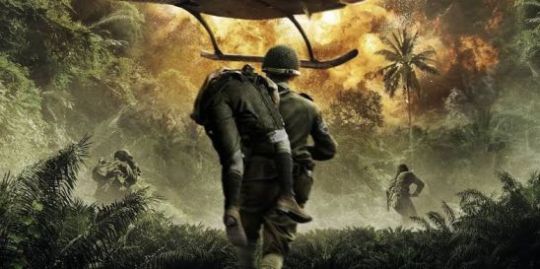
While most of us choose tarnished war movies that distort real-life events slightly and invoke a spirit of nationalism in us, others are more likely to see the battlefield more accurately depicted. Whatever one's choice may be, it cannot be ignored that some of the popular films in cinema's history have been offered to us by the war movie genre. We are all very much aware of all the standard English war movies which have been released for over the years, but we do not know that several high-quality films presenting the Korean War have been made even by the South Korean film industry. This means that Korean war movies about such conflicts still exist. So are you interested in Korean War movies or movies about Korean war? You are lucky! We cover all these categories, which have a wide overlap, with this list of the Best Korean War Movies. So here's our list of all the Korean movies that are going to give you an insight into the Korean War.
Best Korean War Movies Ever Made
20- Northern Limit Line
Korean title: 연평해전 (Battle of Yeonpyeong) Directed by: Kim Hak-soon Produced by: Jung Moon-goo Cast: Jin Goo, Kim Mu-yeol, Lee Hyun-woo Release date: June 24, 2015 Running time: 130 minutes Box office: US$38.9 million With a Budget of US$6 million Ratings: IMDb (6.6), Rotten Tomatoes (71%) Why: I thoroughly fell in love with the characters and how they interacted with one another. The film was a little slow-moving initially as we get to know the names, but it was all right. The climactic battle scene was hard-hitting and quite emotional. A maritime Korean war movie, well done!
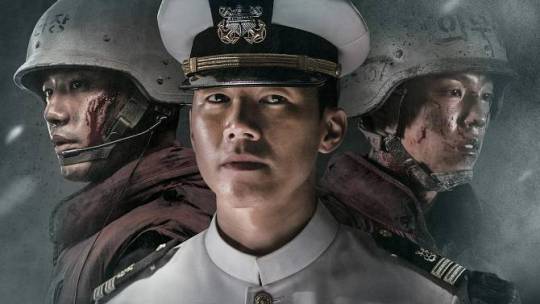
Plot: PKM 357 perceives the trawlers and their crew, allowing the spies to become acquainted with the superstructure of the ship. Because of the government's Sunshine Strategy, the North Koreans are finally released upon orders from the South Korean higher command. North Korea's Navy will regularly reach South Korean waters over the next month to identify and survey the patrolling strategies and protective steps of the ROK Navy. The South Korean Ministries of Defense is informed of this but the Blue House is again told not to engage first. The Second Battle of Yeonpyeong began with a surprise assault by a North Korean patrol vessel on PKM 357. Until reinforcements from the South arrive, the coming war badly cripples all ships and forces the North's patrol ship to withdraw. Nineteen wounded and four deaths from uncontrollable fires are reported before PKM 357 sinks. In the Republic of Korea Navy, whose bravery and comradeship the film brings front and center, you'll also develop a new appreciation for sailors.
19- White Badge
Directed by: Chung Ji-young Produced by: Chong Nam-gook Cast: Lee Geung-young, Ahn Sung-ki, Shim Hye-jin Release date: 1992 Running time: 124 minutes Box office: Unknown Ratings: IMDb (6.7), Letterboxd (3.3/5) Why: The film gives hints of how the war in Korea was depicted (a lot of gov't censorship), the grievances of the "poor" Koreans competing for the "rich" Americans as proxies, and the reality that several of these Koreans turned to their own country where there is a constant presence of US troops. Even, I suppose it's worth your time watching this Korean war movie to get an insight into the experience of Vietnam that you may not be able to get anywhere else.
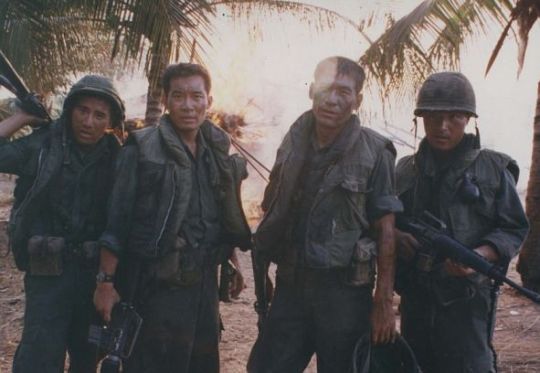
Plot: WHITE BADGE, based on a book, deals more with the consequences of human massacres in battle than with war itself. This gives a seldom-seen view of the Vietnam War from the participation of Korean soldiers in that unjustifiable proxy war; it juxtaposes the misery of the Vietnamese with the exploitative relationship between South Korea and America. At one point, the main hero, who is a novelist, recalls the involvement of the American army during his childhood in the Korean War. Otherwise, the top Korean war movies mostly switches between two periods of time, the horrific scenes in the late 1960s Vietnam War and the turbulent present with the uprising against martial law in late 1979 and early 1980. He had PTSD, an attempt at writing a serialized Vietnam War novel. Han receives several calls from his old friends during the war, despondent and living in isolation. The film gradually exposes their experience of war and shows the degree to which these two men are affected. In the first half, the film has some pacing problems, and the message is open and often artificial, but clear and evident. Even for watching this under-seen south Korean war movies , the cathartic end alone is worthwhile.
18- Ode to My Father
Korean title: 국제시장 (Gukjesijang) Directed by: Yoon Je-kyoon Produced by: Park Ji-seong Cast: Yunjin Kim, Hwang Jung-min Release date: 17 December 2014 Running time: 130 minutes Box office: US$125 million With a Budget of US$30 million Ratings: IMDb (7.8), Rotten Tomatoes (71%) Why: Realistic portrayal of a common man who thrived for all miseries to keep the promise he gave to his father. This Korean war movie walks you through the history, life, love, and sacrifices of forgotten people in this present. The actors, the cinematography, story all give us a rollercoaster ride of emotions. I encourage others to watch this movie when you feel life is hard and you are lost. If you watch this with your heart open, you will get to know many lessons.
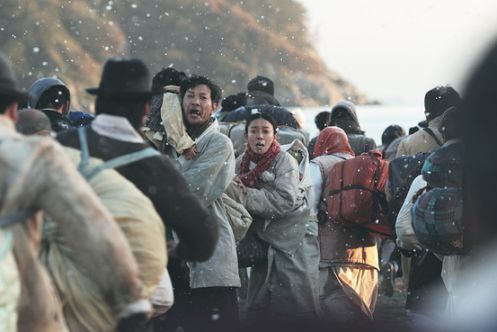
Plot: During the Korean War of 1950, when a lot of refugees were brought to the south by the U.S. A boy lost his sister, and his father keeps behind to look for her, advising his son to take his two younger siblings with his mother to the port town of Busan, where his aunt operates an imported goods shop. The father vows him to be the caretaker of his place before leaving the family. He becomes his family's breadwinner from an early age, doing all sorts of odd jobs to support the family. In 1960, he traveled to Europe with his best friend, where they find dangerous work in German coal mines to pay for his brother's University Fee. He falls in love with a fellow, survives a mining accident, and leaves Germany after his visa expires. They have a modest wedding, begin a life together, and eventually have two sons. Find the remaining story after watching these Korean war films.
17- My Way
Korean title: 마이 웨이 (Mai Wei) Directed by: Kang Je-gyu Produced by: James Cho Cast: Joe Odagiri, Jang Dong-gun Release date: December 21, 2011 Running time: 119 minutes Box office: US$16.5 million Ratings: IMDb (7.7) Why: I found this in Korean war movies list as entertaining for a Korean audience and focused on the Korean people's pain and suffering. If that was its primary target, it was successful, but An international audience also enjoyed the movie. There were plenty of characters that could have been grown more through the film and had their direction. It is really the best war movie to be enjoyed.
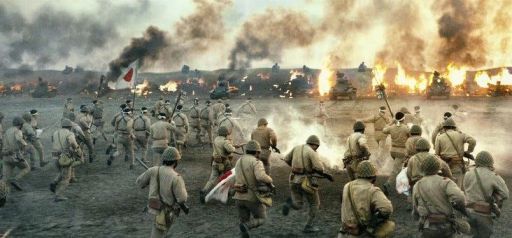
Plot: Young Kim (main Character), along with his father and sister, worked on the Hasegawa family farm in Japanese-occupied Korea in 1928. Both brothers are skilled in running and become strong competitors by the age they are teens. In a bomb attack, a Korean war criminal kills his grandfather, and a Korean runner then wins a full marathon against Japanese competitors. He later began working as a rickshaw driver, and Koreans were barred from engaging in sports at that time. Even though he has been admitted by a medical college in Berlin, Tatsuo chooses to stay in Korea to run a marathon in an All Japan Trials. As punishment, they were drafted into the Japanese army. With 100 other Koreans, they fought in the battle on the Mongolian border, where a Chinese sniper—this film itself a war mystery and a must watch movies about the Korean war.
16- The Bridges at Toko-Ri
Directed by: Mark Robson Produced by: William Perlberg Cast: Mickey Rooney, William Holden Release date: December 1954 (U.S.) Running time: 102 minutes Box office: $4.7 million With Unknown Budget Ratings: IMDb (6.7), Rotten Tomatoes (80%) Why: This Korean war movie is about fear and the potential loss of life, liberty, and family. Fact is often stranger than fiction, and characters similar to some shown here exist; the bowler hat is no stranger to war zones. This film shows carrier ops in some detail, which adds to the realism, and the flying sequences are good. I am surprised by the storyline in some areas; that's why it makes up for an outstanding war movie.
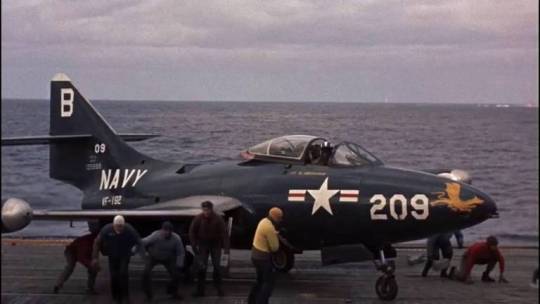
Plot: The Bridges of Toko-Ri is a weighty drama that unveils the grotesque underbelly of war. "Forney" had also been in trouble brawling and wearing a green top hat and scarf that was non-regulatory when flying his helicopter as an aid to downed water pilots. The Carrier commander took an interest in him, back on board his ship as he remembers a Navy pilot murdered in World War II. The Savo Island heads to Japan's port, where Brubaker and his family are granted three-day shore leave in Tokyo. Whenever anyone comes to him looking for his assistance in bailing Forney out of the brig after a brawl, the reunion is disrupted. When his wife hears that he had to drop his jet at sea, Nancy gets angry and threatens her when we return to Korea. The Bridges at Toko-Ri are brilliantly filmed, and the once-taboo subjects of fear and tension in battle are confidently discussed.
15- Sayonara (1957)
Directed by: Joshua Logan Produced by: William Goetz Cast: Patricia Owens, Marlon Brando Release date: December 5, 1957 Running time: 147 minutes Box office: $26.3 million With Unknown Budget Ratings: IMDb (7.1), Rotten Tomatoes (93%) Why: I enjoyed Korean war movies as I thought the main character did an excellent job and showed a kinder, softer side of his acting ability. The Japanese actresses performed well, and the costumes, choreography, and scenery as breathtaking. I watch this movie a lot and enjoy it every time as the plot seemed contrived. This movie portrayed the contrast clearly between the Japanese and American cultures and compellingly. To me, the film Sayonara meant "sad" rather than "goodbye."
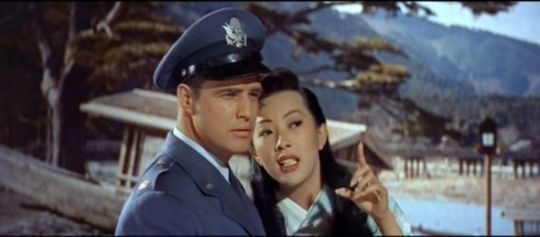
Plot: The main character, "Ace," is a U.S. Air Force Fighter, the son of a U.S. Army General who is stationed at Itami Air Force Base, near Kobe, Japan, and has been rehired from combat assignments in Korea. Despite the opposition of the United States military establishment, another soldier, the enlisted crew chief of Ace, is about to marry a Japanese woman, who would not accept interracial marriage because it is usually illegal under American law. The Air Force is against the marriage, so Both Air fighters argue, but later Ace apologizes and becomes his best man at the wedding. Ace falls in love with a Japanese entertainer who works in a theater company. She suspects that Ace is in trouble and heads towards him to warn, but when she learns that Joe's house has been under Army surveillance, where she discovers that he has been seeing a local woman. These types of movies about Korean war story is exceptional, and hard to find any unrealistic scene.
14- Men in War (1957)
Directed by: Anthony Mann Produced by: Sidney Harmon Cast: Aldo Ray , Robert Ryan Release date: January 26, 1957 Running time: 102 minutes Box office: $1.5 million With Unknown Budget Ratings: IMDb (7.2), Rotten Tomatoes (89%) Why: It is one of the Best directed or the imaginary best Korean war movies; it seemed as though you were in the scene yourself watching from a tree. The movie is relaxed, quite soulful, so even though you might argue that the soldiers were stereotypical, they were so credible, and that they behaved so well, they also seemed to be part of that world. The actors are superb, totally reasonable, and the scenes are heart-breaking. I recommend this film to anyone; it's merely the best largely unknown war film ever.
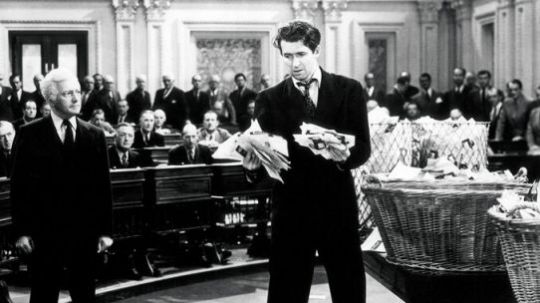
Plot: Because of losing radio communication, an isolated and tired platoon is cut off and harassed by unidentified North Korean snipers who secretly kill the American soldiers and take their weapons. There are just unclear directions for the platoon leader to hit a specific hill to meet up with American forces. The patrol stops a jeep with shell-shocked passenger "the Colonel," who cannot speak and is tied to his seat. The squad is on its way to the mountain. Montana shoots a surrendering North Korean sniper, who points out to have a hidden weapon inside his cap. Montana turns the platoon back into a combat unit and proceeds successfully through sniper assault, artillery fire, and minefields, during which Sergeant Lewis is killed. As all the deaths are depicted as essentially meaningless, it is a classic example of the meaningless cruelty of war. Another well-made feature of the south Korean war movies is the scenery, whose dullness and peace contrast with the anticipation and suspense that war brings.
13- Wolmido
Known as: Wolmi Island Directed by: Gyong-sun Cho Written by: Lee Jin-woo Cast: Gyong-sun Cho, Hyun Chang-Gyeol Release date: 1982 Running time: 92 minutes Box office: Unknown Ratings: IMDb (5.4) Why: Naturally, it is an exciting film as it gives the impression of the Korean War from the side of the North Koreans for a change. This is a comparatively small-scale movie in which the plot focuses on the efforts of North Korean soldiers to protect their island territories from the colonial villains' overwhelming power, the USA. I went into this not knowing what to expect, except maybe some funny cheesiness. Well, I got what I expected from top Korean war movies but also a lot more.
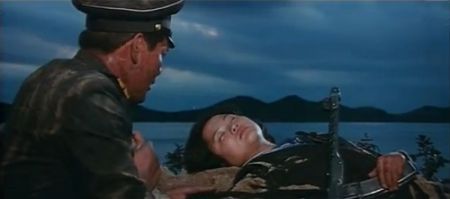
Plot: To spice up this list, we've added Wolmido—one of North Korea's most popular war movies. This North Korean vividly represents the tragic fate of the coastal battery unit that fought to the last man protecting the Wolmi Island in September 1950. The North Korean commander and his team men tested the UN landing activity for three days by showing remarkable courage and a more fantastic standard of self-sacrificing faith, countering 50,000 soldiers and over 500 warships. This film also portrays the role of women in participating alongside men on the front line and to the rear in the Korean War.
12- Fixed Bayonets! (1951)
Directed by: Samuel Fuller Produced by: Jules Buck Cast: Gene Evans, Richard Basehart Release date: 1951 Running time: 92 minutes Box office: $1.45 million With Unknown Budget Ratings: IMDb (6.9), Rotten Tomatoes (100%) Why: This is an exciting Korean war movie to watch on themes of responsibility and its inevitability. The role is to be the leader of a guerilla war in this film to prevent the North Koreans from shutting down in on a battalion to withdraw. The chain goes from the regimental officer, who we see as the film begins, a sort of one of the guys" with a wad of chewing tobacco, grouped in a tent with other men, to a younger lieutenant who is the group appointed to replace the guerilla war.
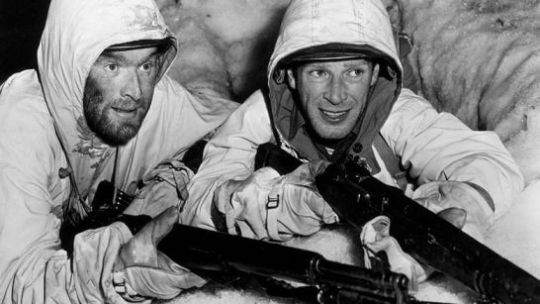
Plot: The Korean War was fought in one of the world's most unforgiving conditions. The story is set during the Red Chinese Invasion during the first winters of the Korean War. The tale follows the fate of a lone 48-man platoon left to protect a choke point as a rearguard, to cover the retreat of their division over an exposed bridge. The plotline alone shows what a crazy film this is, going where no film had gone before. Fixed Bayonets! is as thrilling as it is depressing, as most war movies tend to be; it's a grim reminder of what war does to men.
11- Operation Chromite
Korean title: 인천상륙작전 Directed by: John H. Lee Jae-han Produced by: Lee Kyu-chang Cast: Lee Beom-soo, Lee Jung-jae Release date: 27 July 2016 Running time: 111 minutes Box office: US$50.9 million With a Budget of US$50.9 million Ratings: IMDb (6.2) Why: Patchy and half baked, but worth a onetime watch. These movies about Korean war does tell an important story that would otherwise fade away. The Korean War isn't something considered particularly pivotal in a global context. Read the full article
#71:intothefire#alittlepond#actionkoreanwarmovies#americankoreanmovies#ancientkoreanwarmovies#battleonshangganlingmountain#bestKoreanwarmovies#chinesemoviesaboutkoreanwar#koreanactionmovies#koreanairwarmovies#koreanmovies#koreanwardramaseries#Koreanwarfilms#Koreanwarmovie#koreanwarmoviebrothers#Koreanwarmovies#koreanwarmovies2020#koreanwarmoviesimdb#koreanwarmoviesnetflix#koreanwarmoviesonline#koreanwarseriesonnetflix#moviesaboutKoreanwar#moviesabouttheKoreanwar#reignofwarkoreanmovie#southKoreanwarmovies#thefrontline#thegeneralkoreanmovie#thekoreanwardocumentary#topKoreanwarmovies
0 notes
Text
Dec 13, 2019
1. Amanda Bynes, 33, has checked out of her sober-living facility and is staying with her parents while she looks for a place on her own, “Entertainment Tonight” reported. The trio, alongside Bynes’ conservatorship attorney, appeared in court on Thursday to meet with a judge to make sure the move was acceptable now that she’s no longer living in an in-treatment center. A source told the outlet that Bynes is content with the arrangement and maintains a close relationship with her parents. Page Six has reached out to Bynes’ rep and attorney for comment. Bynes received a day pass in June to leave the facility so she could attend her graduation from California’s Fashion Institute of Design and Merchandising. The now-sober actress first enrolled in the design school at the end of 2014. She was reportedly kicked out of the school for causing “horrendous arguments” with classmates, but in 2017 got back on track to graduate.
Bynes checked into a mental health facility in early 2019 following a stress-related relapse.
Additionally, Bynes also received treatment for drug addiction. She told Paper magazine that drugs had contributed to her issues earlier in the decade, but that she had been sober for the past four years.
“Those days of experimenting [with substances] are long over,” she told the magazine. “I’m not sad about it and I don’t miss it because I really feel ashamed of how those substances made me act. When I was off of them, I was completely back to normal and immediately realized what I had done — it was like an alien had literally invaded my body. That is such a strange feeling.”
2. Keke Palmer and comedian Joel Kim Booster are bringing ’90s dating game show “Singled Out” back to life. The reboot goes modern and will “bring online dating to life with a twist — the main dater is linked to the pool of diverse singles through social media,” a news release from MTV Studios and Quibi revealed Friday. The show will also “hook up a new generation of singles, of all genders and sexual preferences.” The show will run for 20 episodes on Quibi, launching in spring 2020. It is being produced by MTV Studios.“I am thrilled to be hosting ‘Singled Out,’” Palmer, a co-host of ABC “Strahan, Sara & Keke,” said in a statement.“To be able to reimagine this show for my generation and on a new platform is so exciting,” the 26-year-old added. “Can’t wait for you guys to see what we have in store!” The original “Singled Out” was hosted by Chris Hardwick and Jenny McCarthy, with Carmen Electra replacing McCarthy for the last season and a half. It ran from 1995 to 1998 on MTV. During the initial run, the main contestant got matched — after questions, games and stunts — with one of 50 possible dates.
3. While accepting the first-ever Woman of the Decade honor at the Billboard Women in Music event on Thursday, Taylor Swift slammed industry foe Scooter Braun and the institutionalized sexism she says she’s experienced at the hands of the recording industry. Swift, who turns 30 on Friday, also called out those who supported Braun when she first blasted his acquisition of her master recordings through his purchase of her old record label.
“The definition of the toxic male privilege in our industry is people saying ‘But he’s always been nice to me,’ when I’m raising valid concerns about artists and their right to own their music,” Swift said during her 15-minute-long speech. “Of course he’s nice to you. If you’re in this room, he has something that he needs. “The fact is that private equity is what enabled this man to think, according to his own social media post, that he could ‘buy me,’ but I’m obviously not going willingly.”
Braun has maintained that he’s reached out to the “Lover” singer numerous times in order to smooth over their ongoing feud but he claims his attempts prove futile. On Thursday, however, Swift said she hasn’t heard from anyone from Braun’s group, Ithaca Holdings.“Yet, to this day, none of these investors have ever bothered to contact me or my team directly, to perform their due diligence on their investment, on their investment in me, to ask how I might feel about the new owner of my art — the music I wrote, the videos I created, photos of me, my handwriting, my album designs,” she continued. “And of course, Scooter never contacted me or my team to discuss it prior to the sale, or even when it was announced.”
Despite what she said in her speech, Swift previously appeared to admit to Vogue that she passed on the opportunity to purchase her masters.“ It was either investing in my past or my and other artists’ future, and I chose the future,” Swift told the publication of the deal she struck with UMG.At the time the news of Braun’s acquisition of her masters went public, a source also confirmed to Page Six that the pop star had “months” to buy back her masters but chose to “walk away” in favor of a new deal with Universal.
“In the entire time of negotiations, she never once reached out about wanting her masters,” our source said.
4. Former HGTV host Christopher Dionne has been sentenced to three years in prison for molesting a 10-year-old girl during a sleepover at his Connecticut home in 2017. Dionne, 37 — who hosted the “Family Flip” pilot episode for the home improvement network — maintained his innocence and is expected to appeal his conviction for fourth-degree sexual assault and risk of injury to a minor.Following his prison sentence, Dionne must serve 10 years of probation and register as a sex offender, a judge ruled Wednesday, according to the Hartford Courant.
Dionne’s victim, now 12, testified during his trial that she was best friends with his daughter and was sleeping over at their house when she was assaulted in November 2017. The girl said Dionne molested her twice while his two children, then a 10-year-old daughter and 14-year-old son, slept in the same room. The reality show host was in his boxers and asked if the child wanted to touch his penis, she said. He groped her chest and backside. Dionne then told his victim: “Don’t tell your mom, I’ll go to jail and [my daughter] won’t have a daddy.”
The victim didn’t attend Wednesday’s sentencing hearing, but her mother delivered an emotional statement to the court, according to The Day in Connecticut. “How much is a little girl worth?” the mother asked. “How much is a family worth?”The mom recalled how her daughter received hateful messages on social media after coming forward and kept saying: “Mom, this ruined everybody’s life. I should have never told. I just wanted to be a normal kid.”
In addition to the victim’s testimony, the state presented evidence that Dionne’s DNA was found in the inner waistband of the child’s pajama bottoms during a forensic review by specialists at the Yale New Haven Children’s Hospital. Dionne denied wrongdoing, telling cops that when he got home, the victim was awake and began to put her arms around him. He was filming the A&E show “House Rescue” in California when police began the investigation. A&E suspended production of the series after the allegations were made public.
5. Actor Colin Firth has announced he has split from his wife Livia but said they remain 'united in their love for their children' almost two years after it emerged she had an affair with her childhood friend. The 59-year-old Love Actually star confirmed the news in a statement today, and insisted he would maintain a 'close friendship' with Livia. The couple have been married for 22 years, and have two sons, Luca and Matteo. A statement from their publicists today said: 'Colin and Livia Firth have separated. They maintain a close friendship and remain united in their love for their children.'They kindly ask for privacy. There will be no further comment'. Their split comes after it was revealed in March last year that Mrs Firth was alleged to have had a year-long affair with Italian journalist Marco Brancaccia.
0 notes
Text
#MeToo in B Major
A deeper look into a sector of the #MeToo movement that never made its break
By Lisa Lee
The #MeToo movement was made popular by Tarana Burke, the founder, after multiple accusations of notable people in the entertainment industry were being publicized. Most notably, actors and actresses were speaking up about the abuse they had to endure from men in power, like producers and directors, in order to become famous. Because of this movement, a community of sexual assault survivors united and were able to bring down their attackers. However, an industry that is constantly struggling with misogynistic practices has yet to see this kind of justice.

A lot of popular media outlets called sexual assault survivors and asked them to explain their stories of the times they were silenced. The stories are impactful and the fact that the entertainment industry ignited such a large movement shows just how much influence actors and actresses have as seen during election times. But, where is the music industry in all of this?

The music industry, primarily the hip-hop and rap genres, has been questioned on multiple occasions about the usage of crude lyrics—degrading women, talking about their aggressive sexual advances, sometimes acts of physical abuse, misogynistic names. There was also a debate on Twitter during the 2016 election regarding those who oppose and condemn Trump but also listen to hip-hop and rap music, almost all of which include vulgar language. Jay Versace and Quinta Brunson are both popular figures on social media platforms for their creative viral memes, so this debate was like walking on thin ice for them. Some thought they had good points while others stated that those two are “canceled”.


Currently, there is another debate being brought up regarding the 1940′s Christmas classic “Baby It’s Cold Outside” regarding its coercive lyrics that were once seen as flirtatious. A radio station played this song during a Christmas song rotation but was then bombarded by callers who asked them to take it down. Although the song has been popularly covered many times by artists in the past decade, in light of the #MeToo movement, we can now see a shift in the way we hear lyrics. Some of the lyrics that can be heard as assault are when the female vocalist says “Say what’s in this drink?” and “I ought to say no, no, no sir” with the male vocalist replying to each line with “No cabs to be had out there” and “Mind if I move in closer?” in the respective order. The second line goes along with the teaching of consent that “no means no” with the male vocalist then ignoring this line by asking to be closer. However, the reason this is being debated is the fact that people are calling out a song that has been around for half a century while songs today have very crude lyrics that are being overlooked. In this debate, people are using the #MeToo hashtag to express their feelings and start conversations online.

Another way the music industry has shown its lack of progress in the #MeToo movement is through the way Kesha’s battle with the music producer known as Dr. Luke. Kesha and Dr. Luke found each other in 2005 while Kesha was a high school dropout, and that is when she signed a 6-album contract with Dr. Luke’s company before she debuted in 2010. From then on, Kesha had been suffering from sexual, physical, and verbal abuse by Dr. Luke but was unable to escape the torment because of the contract that bound her to her attacker. When this news came to light, many were shocked at how such a tragic happening could be kept a secret for so long. In 2014, she was able to file a lawsuit and bring to light all of the mistreatment she endured in order to remain as a top artist.

In light of Kesha’s trials and the #MeToo movement, survivors of sexual assault were able to come together after being encouraged by those who were victims years ago but still took the time to get their justice. Kesha was able to stand on stage with other supporters and survivors to sing her song “Praying”, a song she had written during her battle with Dr. Luke.
youtube
Although all of the people who spoke up during this movement endured a lot of trial and pain, many of them were finally able to find a community of people just like them. The #MeToo hashtag brought together a community many were searching for but couldn’t find. This shows just why online communities can help so much. There are so many hidden pains that people are going through but feel that they have no one to go to, and this is an example of the internet helping people feel supported rather than isolated. I hope that sometime soon, the music industry will catch up and change the way lyrics are written and women are described. Artists like Kesha have proved that it is possible to make number one hits with lyrics that are meaningful but do not degrade anyone, so it is possible the rest of the industry can follow that path set by those affected by the mentality that women are just objects. So for now, here is a positive listicle that shows all the women who have said “Me Too” with their lyrics.
Sources:
http://time.com/time-person-of-the-year-2017-silence-breakers/
https://www.thisisinsider.com/me-too-hashtag-sexual-harassment-assault-2017-11
https://www.buzzfeednews.com/article/sylviaobell/times-up-metoo-abusive-men-hip-hop?bftwnews&utm_term=4ldqpgc#4ldqpgc
https://ohnotheydidnt.livejournal.com/104076245.html
https://twitter.com/ohnotheydidnt/status/798597991091187713
https://twitter.com/HalfricanTime/status/798324275417587713
https://www.cbsnews.com/news/cleveland-radio-station-stops-playing-baby-its-cold-outside-after-listeners-voiced-concerns-about-predatory-undertones/?ftag=CNM-00-10aab7e&linkId=60408652
https://twitter.com/vfinch/status/1069044270978539521
https://twitter.com/frjohnhollowell/status/993076263240851458
https://twitter.com/jamaicawest312/status/990006398120611840
https://www.billboard.com/photos/6978622/keshas-dr-luke-relationship-timeline
https://twitter.com/JasonDottley/status/958082294509637632
https://www.youtube.com/watch?v=1DvZF-gL5_E
https://www.npr.org/sections/allsongs/2017/10/17/558098166/songs-that-say-me-too
https://www.npr.org/sections/allsongs/2017/10/17/558098166/songs-that-say-me-too
0 notes